Fox Hunting
Topic with 148 items
|
Title
|
Images
|
Item Comment
|
Prefix
|
Number
|
In set
|
Set
|
Set Comment
|
Type
|
Artist
|
Author
|
Size
|
Topics
|
Set Covers
|
Reference
| |
|---|---|---|---|---|---|---|---|---|---|---|---|---|---|---|---|
| 101 |
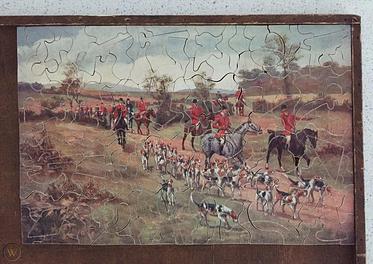
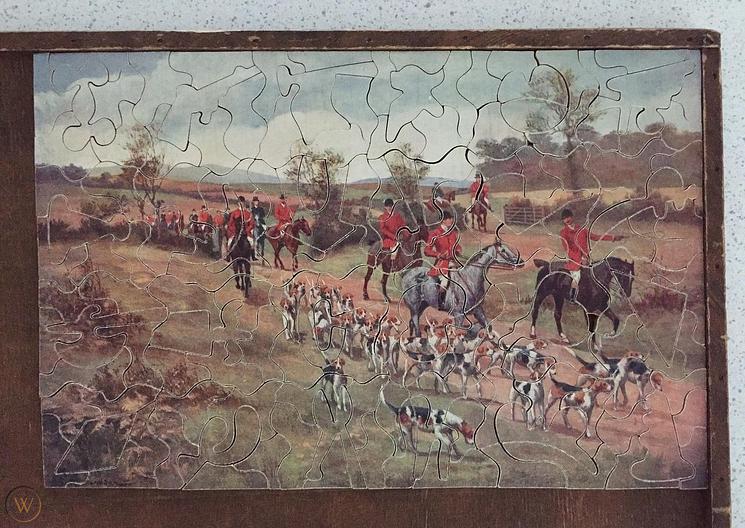
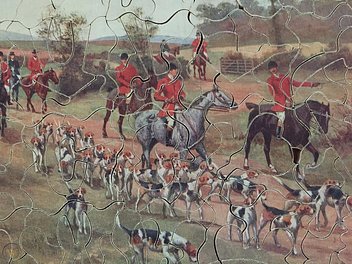



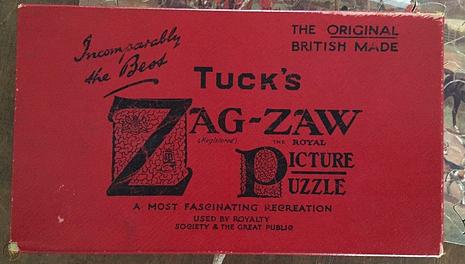
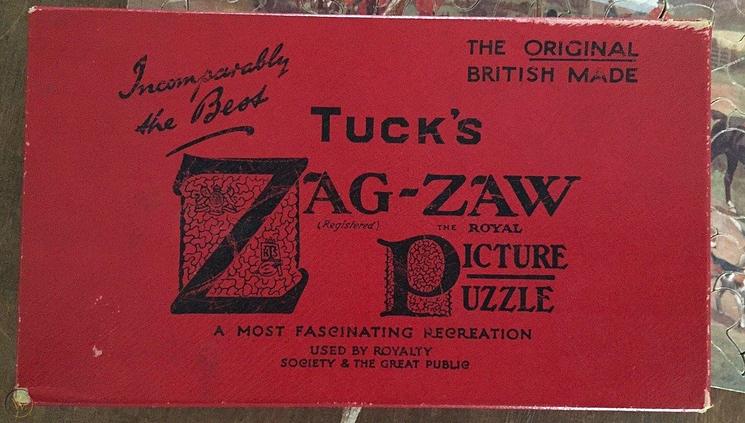

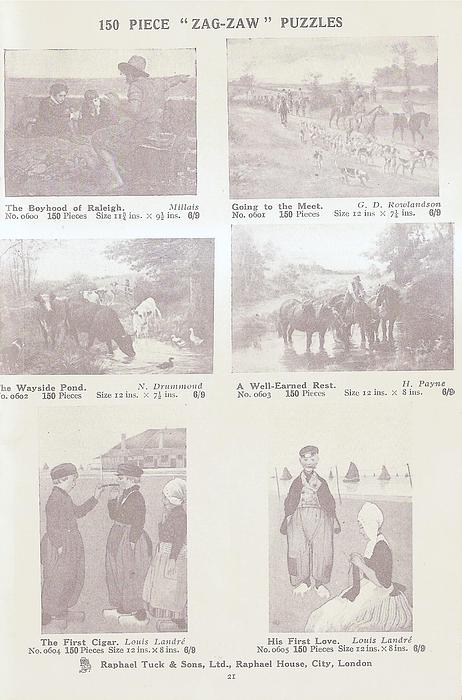
|
about 150 pieces, wooden, figurals, complete with box, push fit style, listed and described in the catalogs,
|
|
601
|
|
Zag-Zaw line of puzzles was first produced in 1909, most incorporate figurals or whimsies, sold in red, orange, or occasionally green boxes with labels on the side or bottom of the box, most without guide pictures. Initially cut non-interlocking but by 1930's became more so. Puzzles have a different cuts so that the same image will come in several versions which means that missing pieces can not be taken from other puzzles with the same image. The puzzle labels are often hand written and come with minor variations in titles and details. Some have a DESIGN category on the label. From my readings this refers to the style of cut, wavy lines, figurals, etc. See also Bob Armstrong's website on old jigsaw puzzles
|
G.D. ROWLANDSON
|
|
12 x 7 1/4 in.
|
|
| ||||
| 102 |
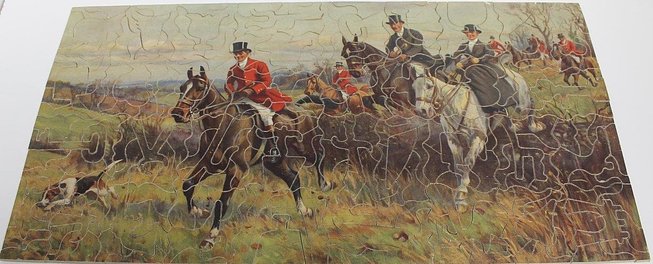

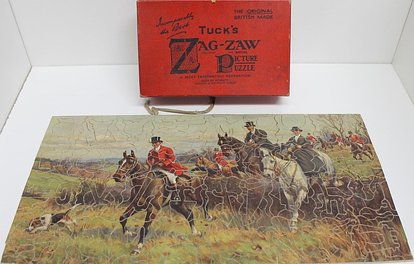

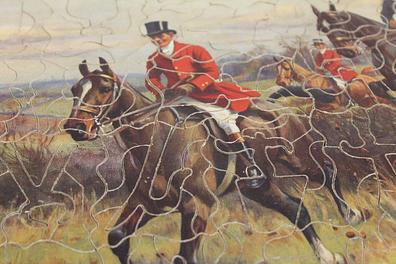
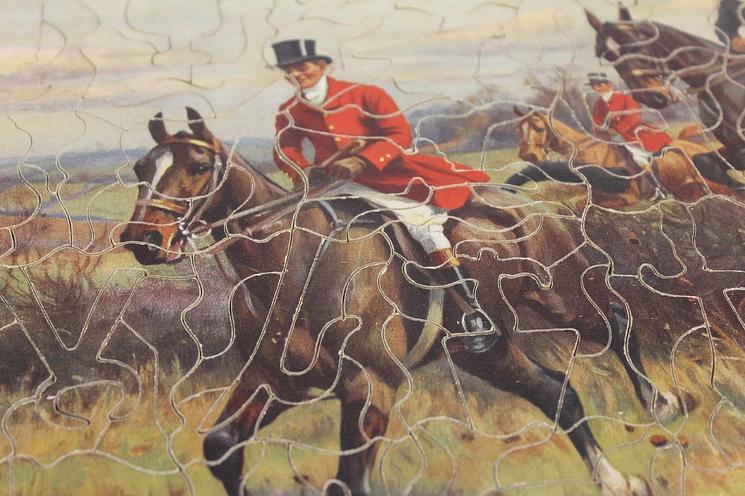
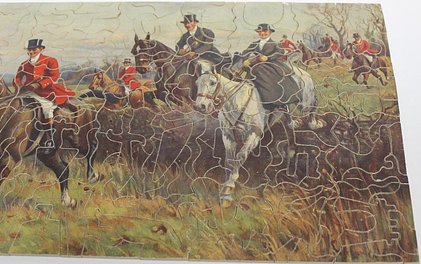

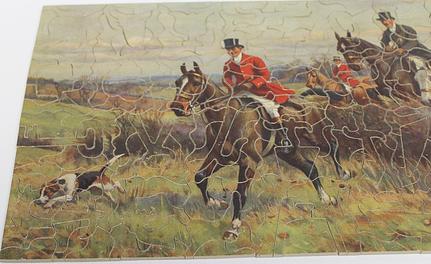
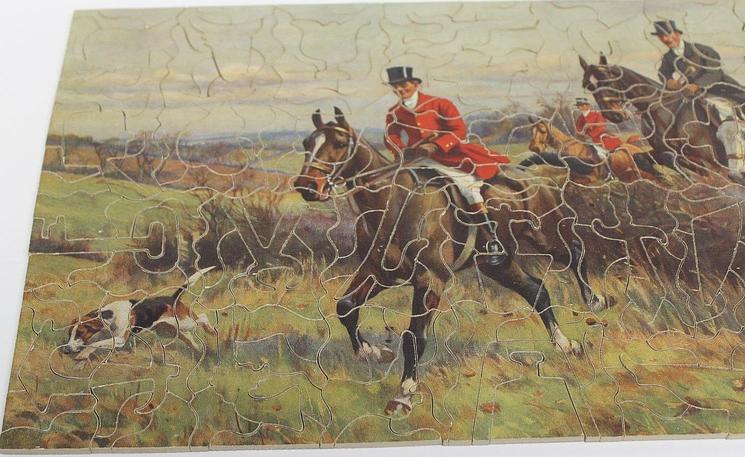
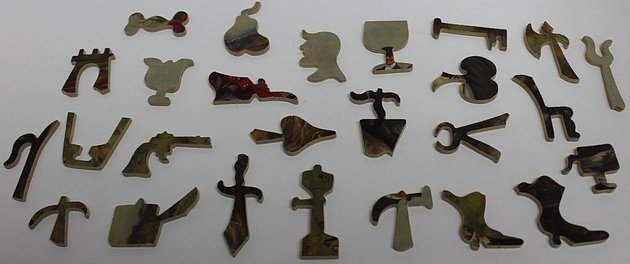

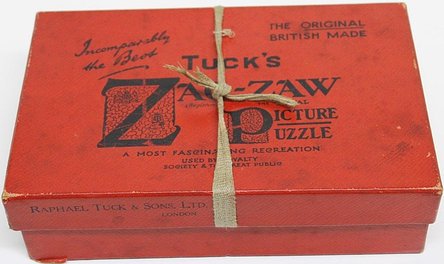
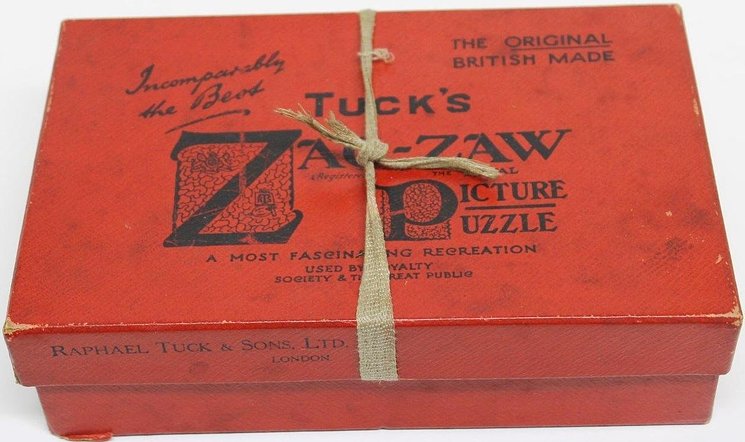
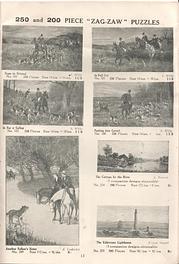
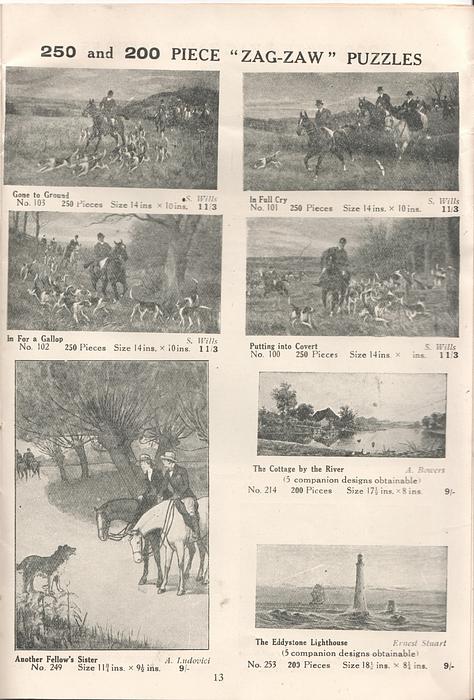
|
250 pieces, same title in another puzzle with the same number of pieces but different in size, this one also has a number, several whimsies, same image is also listed and described in the catalogs as number 101
|
|
408
|
|
Zag-Zaw line of puzzles was first produced in 1909, most incorporate figurals or whimsies, sold in red, orange, or occasionally green boxes with labels on the side or bottom of the box, most without guide pictures. Initially cut non-interlocking but by 1930's became more so. Puzzles have a different cuts so that the same image will come in several versions which means that missing pieces can not be taken from other puzzles with the same image. The puzzle labels are often hand written and come with minor variations in titles and details. Some have a DESIGN category on the label. From my readings this refers to the style of cut, wavy lines, figurals, etc. See also Bob Armstrong's website on old jigsaw puzzles
|
S. Wills probably a pseudonym for John Sanderson-Wells (1872-1955)
|
|
18 x 9 in.
|
|
| ||||
| 103 |


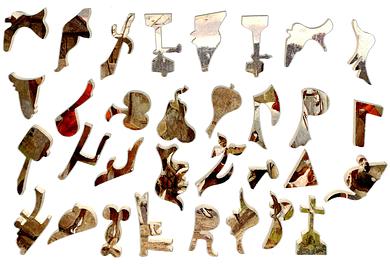
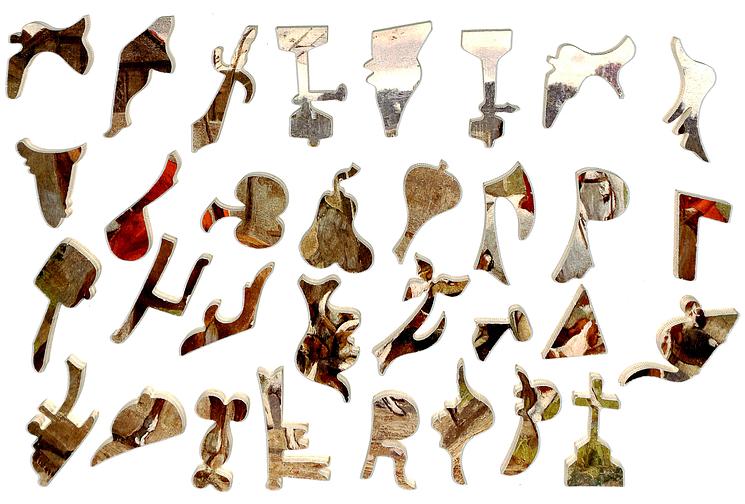




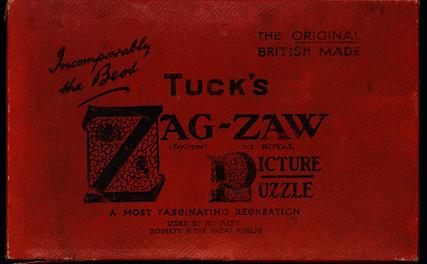

|
200 pieces, wooden, figurals, complete with box, two broken but connected pieces, push fit style
|
|
515
|
|
Zag-Zaw line of puzzles was first produced in 1909, most incorporate figurals or whimsies, sold in red, orange, or occasionally green boxes with labels on the side or bottom of the box, most without guide pictures. Initially cut non-interlocking but by 1930's became more so. Puzzles have a different cuts so that the same image will come in several versions which means that missing pieces can not be taken from other puzzles with the same image. The puzzle labels are often hand written and come with minor variations in titles and details. Some have a DESIGN category on the label. From my readings this refers to the style of cut, wavy lines, figurals, etc. See also Bob Armstrong's website on old jigsaw puzzles
|
LIONEL EDWARDS
|
|
37.5 x 26 cm
|
|
| ||||
| 104 |

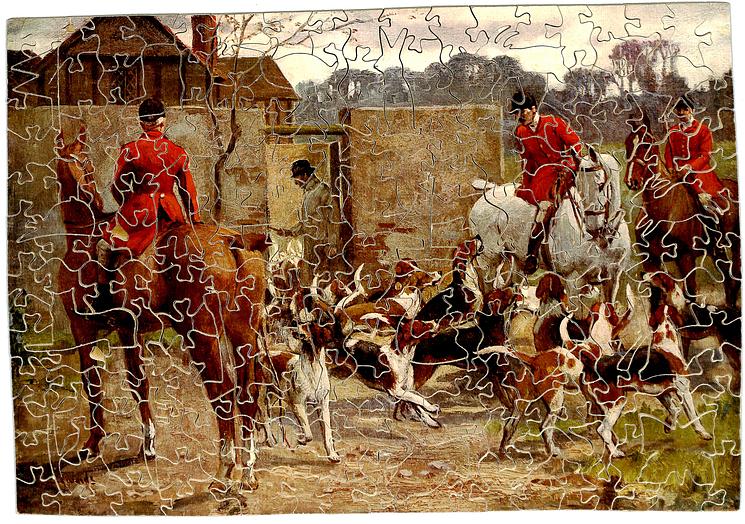
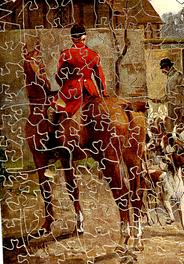
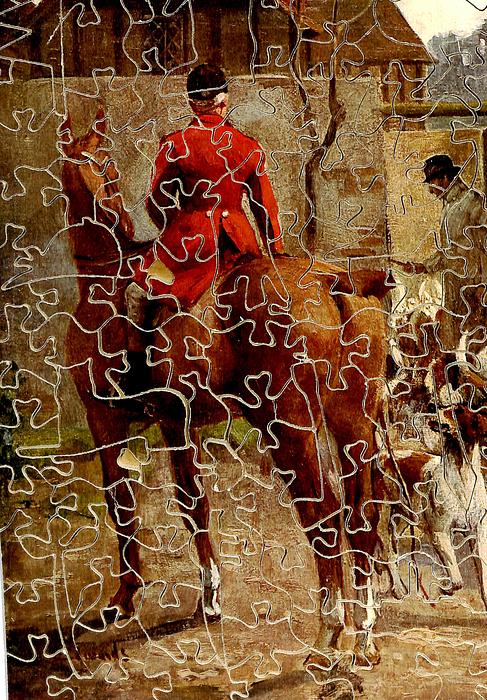
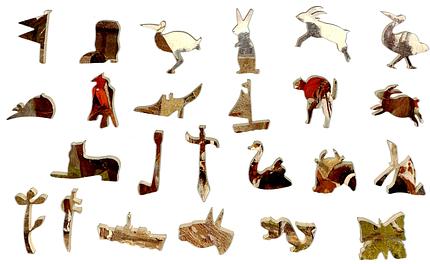

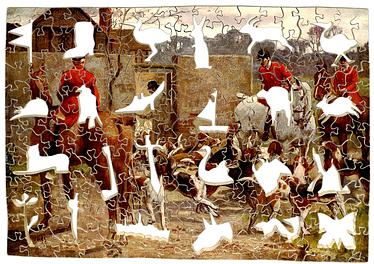
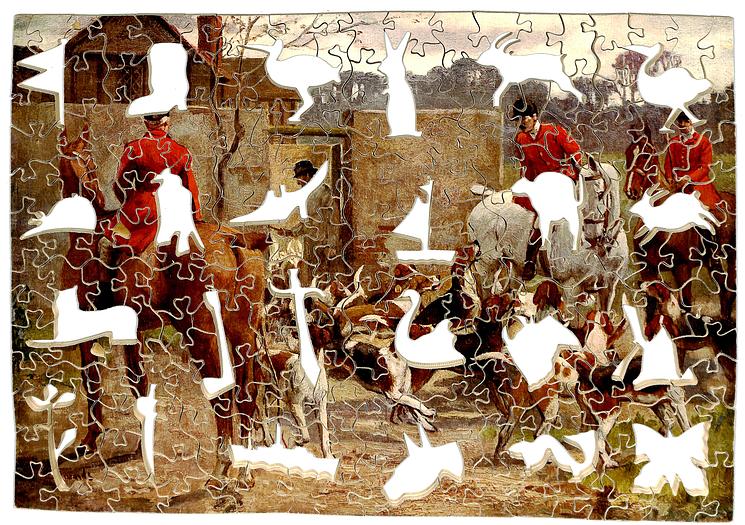
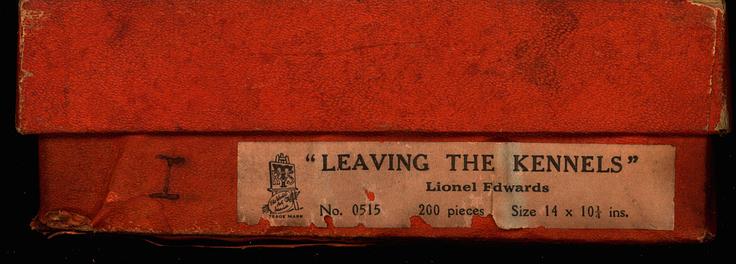

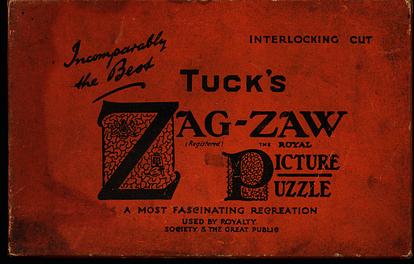
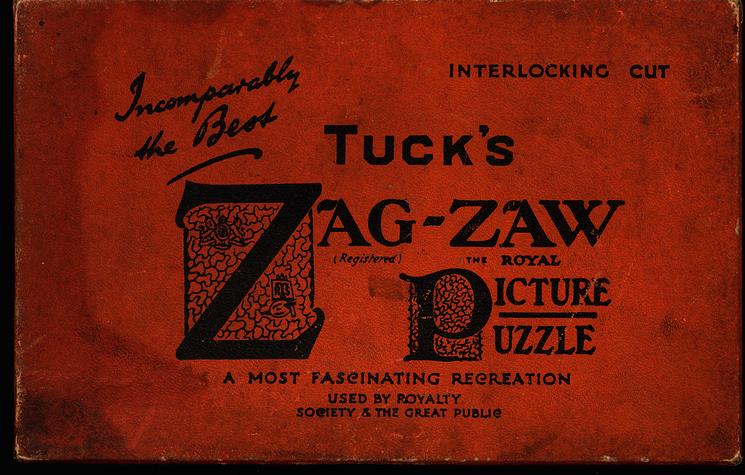
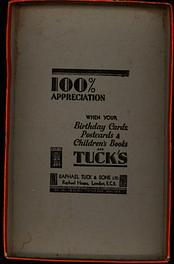

|
200 pieces, wooden, 24 figurals, complete with box, three damaged nibs with no colour, interlocking style,
|
|
515
|
|
Zag-Zaw line of puzzles was first produced in 1909, most incorporate figurals or whimsies, sold in red, orange, or occasionally green boxes with labels on the side or bottom of the box, most without guide pictures. Initially cut non-interlocking but by 1930's became more so. Puzzles have a different cuts so that the same image will come in several versions which means that missing pieces can not be taken from other puzzles with the same image. The puzzle labels are often hand written and come with minor variations in titles and details. Some have a DESIGN category on the label. From my readings this refers to the style of cut, wavy lines, figurals, etc. See also Bob Armstrong's website on old jigsaw puzzles
|
LIONEL EDWARDS
|
|
15 x 10 3/4 in
|
|
| ||||
| 105 |
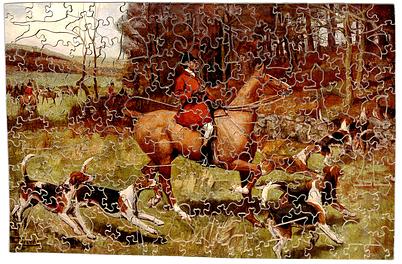

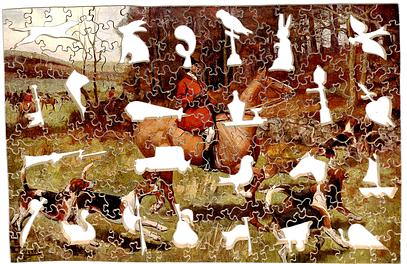
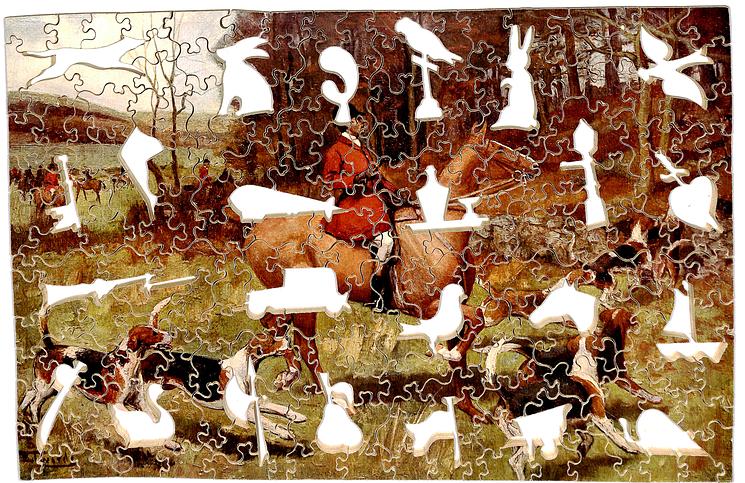


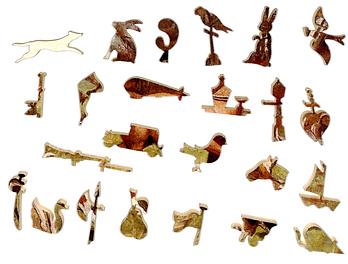

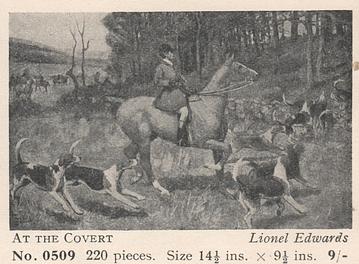

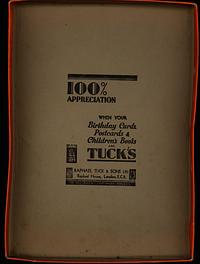

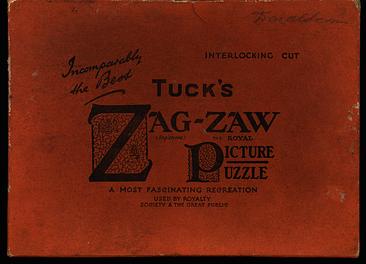
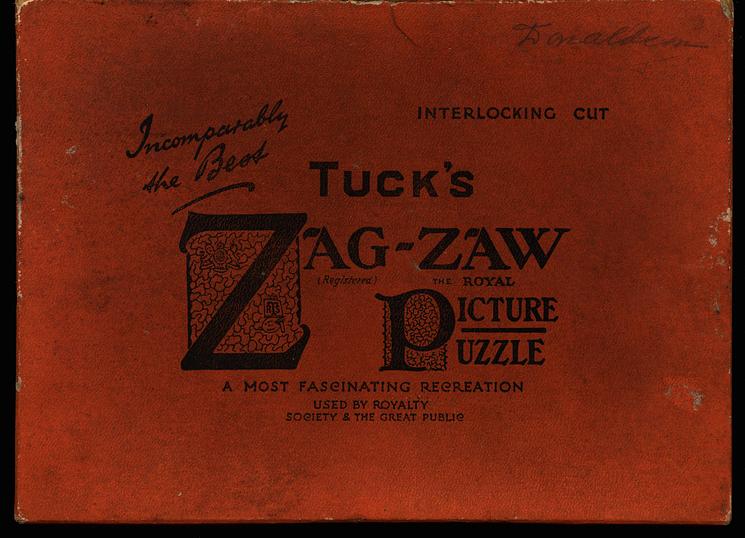
|
200 pieces, wooden, figurals, complete with box, interlocking in styel, listed and described in the catalogs as number 509
|
|
|
|
Zag-Zaw line of puzzles was first produced in 1909, most incorporate figurals or whimsies, sold in red, orange, or occasionally green boxes with labels on the side or bottom of the box, most without guide pictures. Initially cut non-interlocking but by 1930's became more so. Puzzles have a different cuts so that the same image will come in several versions which means that missing pieces can not be taken from other puzzles with the same image. The puzzle labels are often hand written and come with minor variations in titles and details. Some have a DESIGN category on the label. From my readings this refers to the style of cut, wavy lines, figurals, etc. See also Bob Armstrong's website on old jigsaw puzzles
|
LIONEL EDWARDS
|
|
14 3/4 x 9 1/2 in.
|
|
| ||||
| 106 |
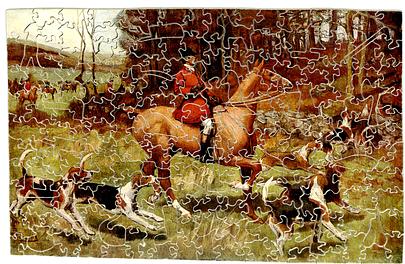

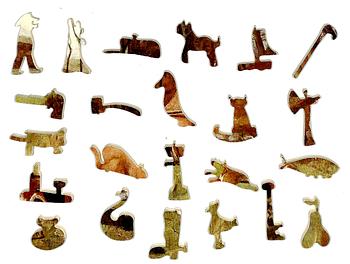
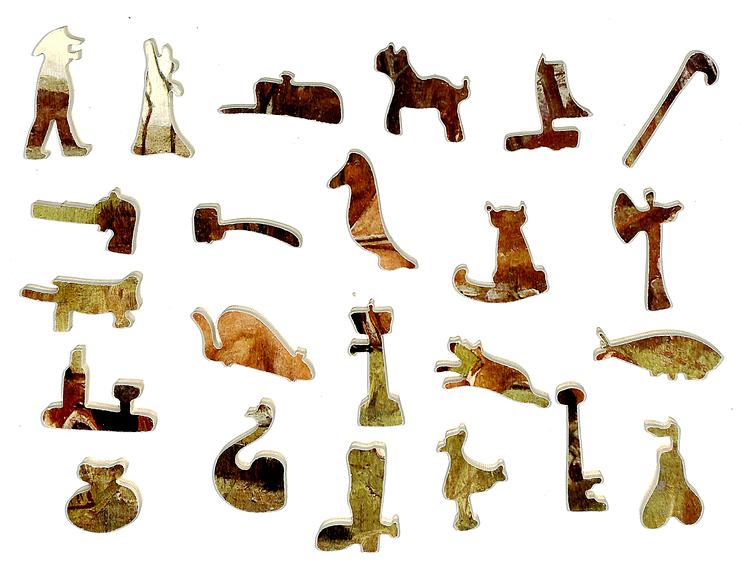
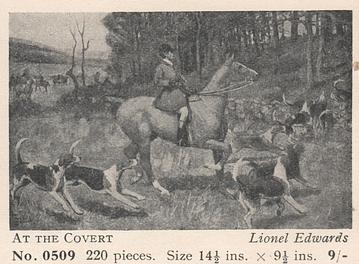
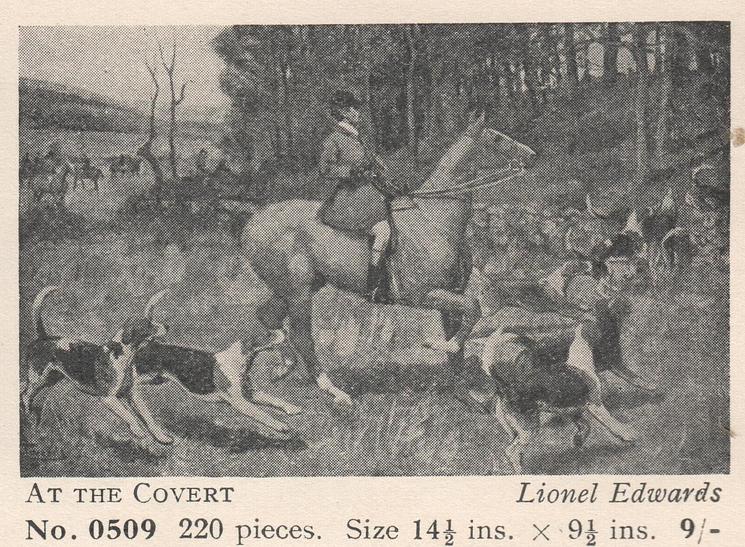
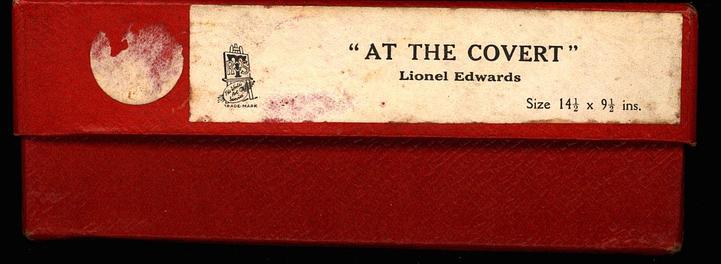
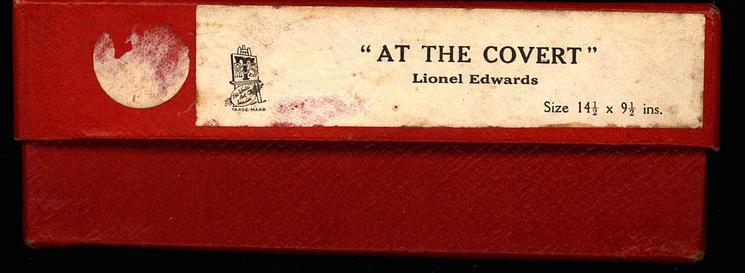
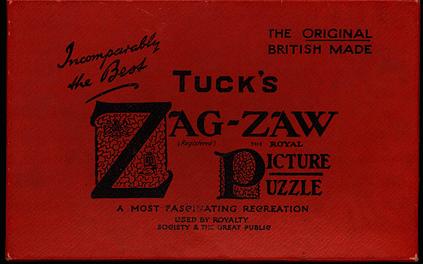

|
200 pieces, wooden, figurals, complete with box, interlocking in stylelisted and described in the catalogs as number 509
|
|
|
|
Zag-Zaw line of puzzles was first produced in 1909, most incorporate figurals or whimsies, sold in red, orange, or occasionally green boxes with labels on the side or bottom of the box, most without guide pictures. Initially cut non-interlocking but by 1930's became more so. Puzzles have a different cuts so that the same image will come in several versions which means that missing pieces can not be taken from other puzzles with the same image. The puzzle labels are often hand written and come with minor variations in titles and details. Some have a DESIGN category on the label. From my readings this refers to the style of cut, wavy lines, figurals, etc. See also Bob Armstrong's website on old jigsaw puzzles
|
LIONEL EDWARDS
|
|
14 3/4 x 9 1/2 in.
|
|
| ||||
| 107 |

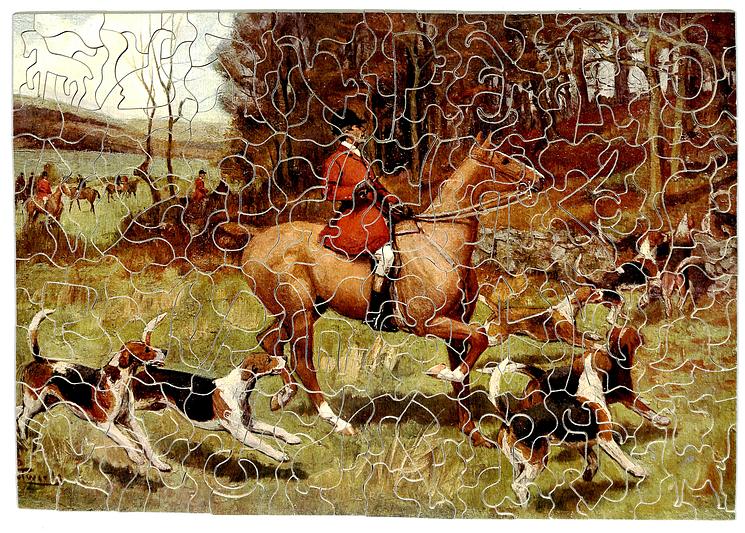
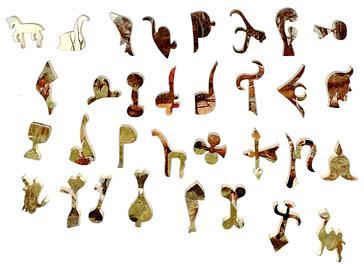

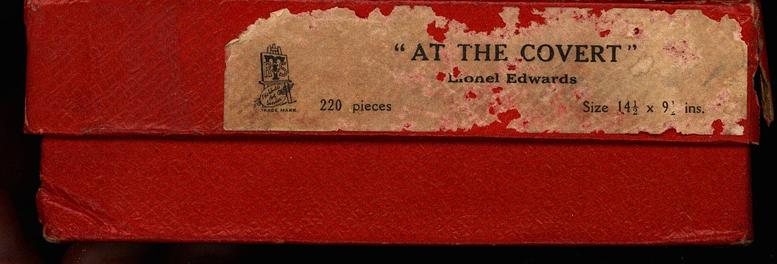

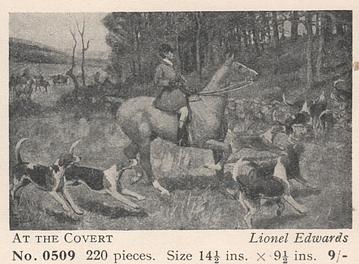
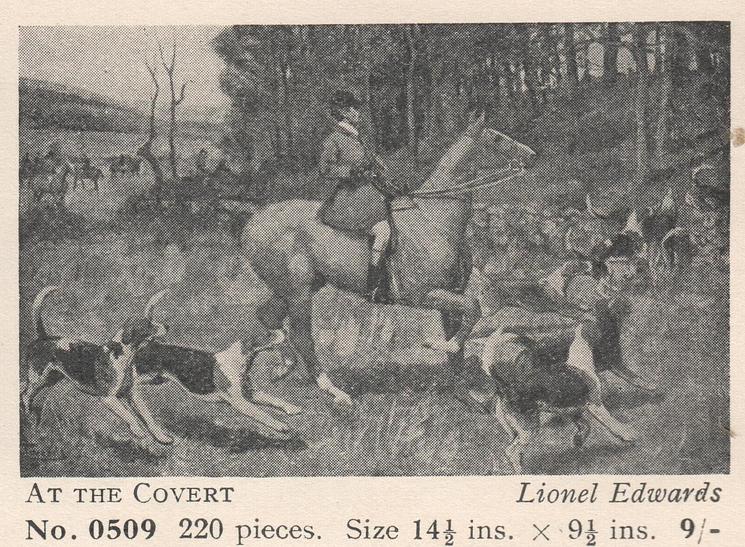
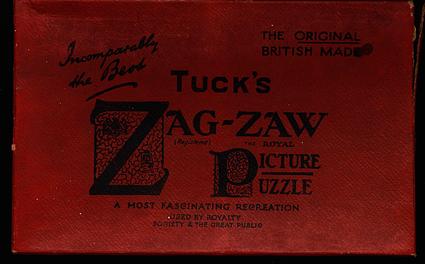

|
200 pieces, wooden, figurals, complete with box, interlocking in styel, listed and described in the catalogs as number 509
|
|
|
|
Zag-Zaw line of puzzles was first produced in 1909, most incorporate figurals or whimsies, sold in red, orange, or occasionally green boxes with labels on the side or bottom of the box, most without guide pictures. Initially cut non-interlocking but by 1930's became more so. Puzzles have a different cuts so that the same image will come in several versions which means that missing pieces can not be taken from other puzzles with the same image. The puzzle labels are often hand written and come with minor variations in titles and details. Some have a DESIGN category on the label. From my readings this refers to the style of cut, wavy lines, figurals, etc. See also Bob Armstrong's website on old jigsaw puzzles
|
LIONEL EDWARDS
|
|
14 3/4 x 9 1/2 in.
|
|
| ||||
| 108 |
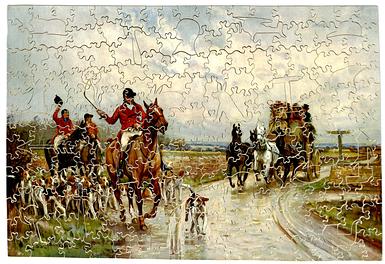

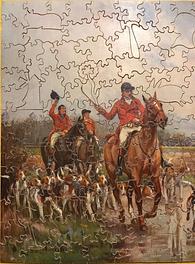
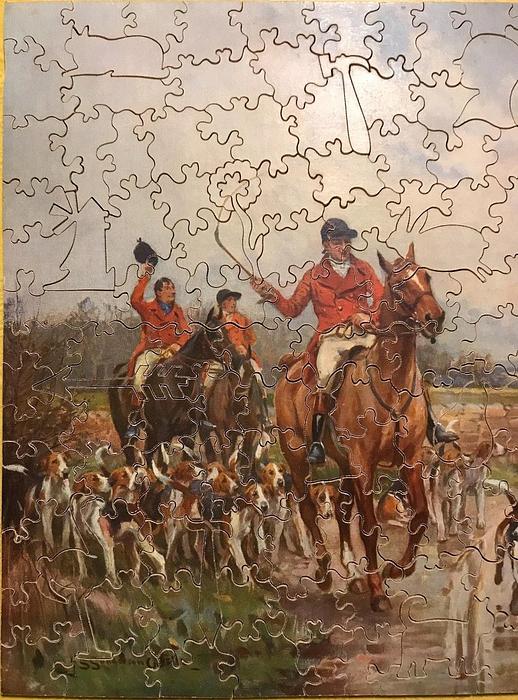
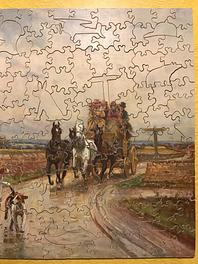

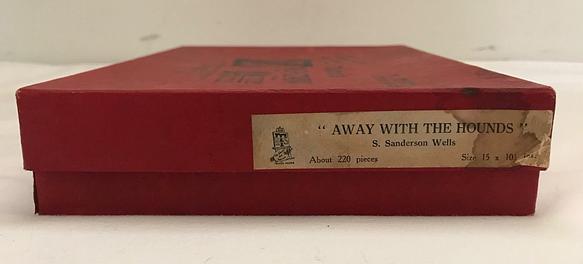

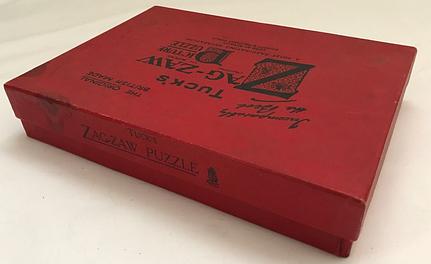
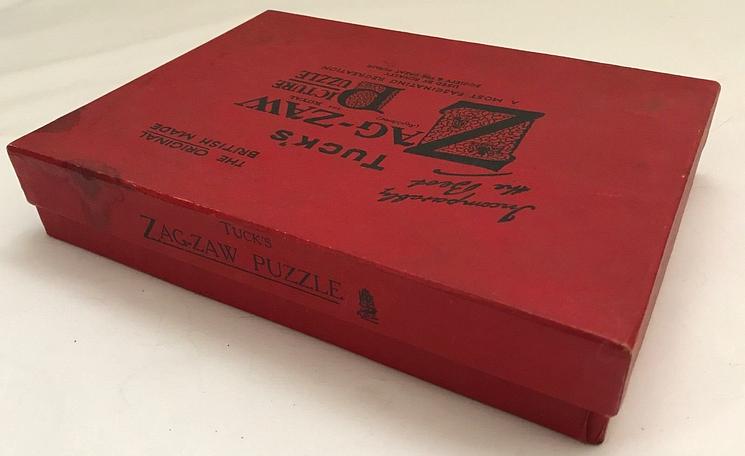

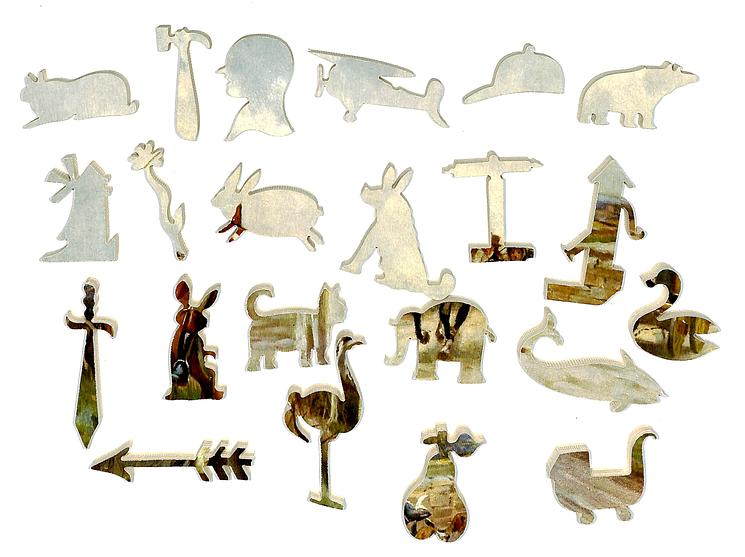
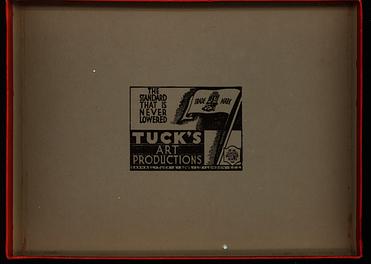

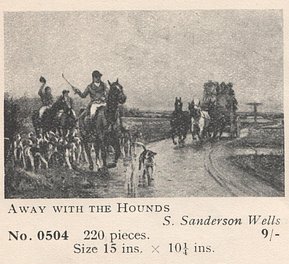
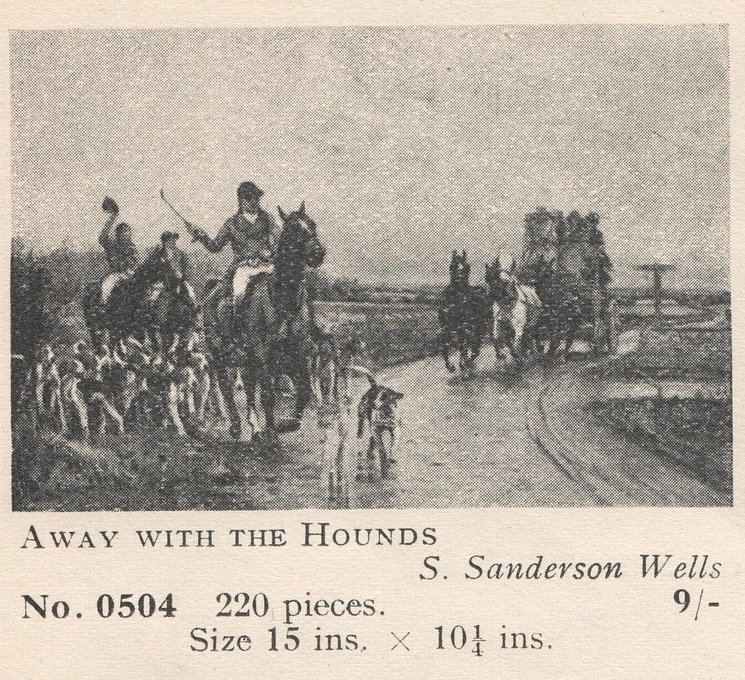
|
about 220 pieces, wooden, figurals, complete with box, interlocking style, listed and described in the catalogs as number 0504
|
|
|
|
Zag-Zaw line of puzzles was first produced in 1909, most incorporate figurals or whimsies, sold in red, orange, or occasionally green boxes with labels on the side or bottom of the box, most without guide pictures. Initially cut non-interlocking but by 1930's became more so. Puzzles have a different cuts so that the same image will come in several versions which means that missing pieces can not be taken from other puzzles with the same image. The puzzle labels are often hand written and come with minor variations in titles and details. Some have a DESIGN category on the label. From my readings this refers to the style of cut, wavy lines, figurals, etc. See also Bob Armstrong's website on old jigsaw puzzles
|
S. SANDERSON WELLS
|
|
15 x 10 1/2 in.
|
|
| ||||
| 109 |
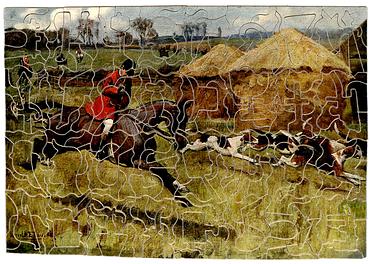
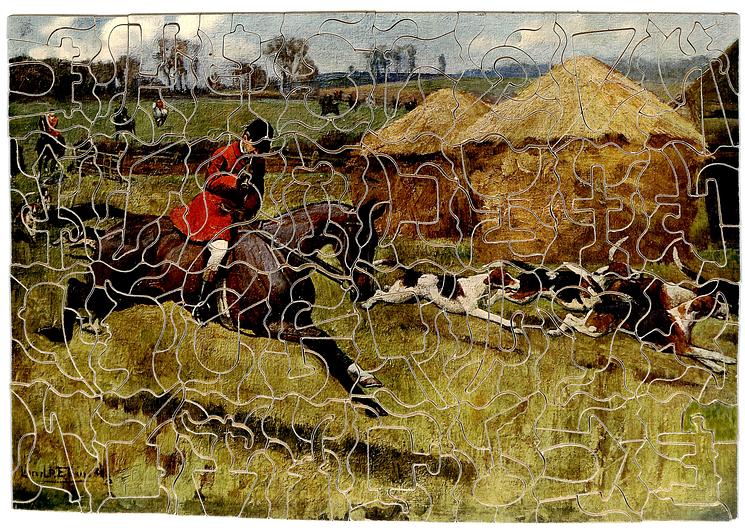
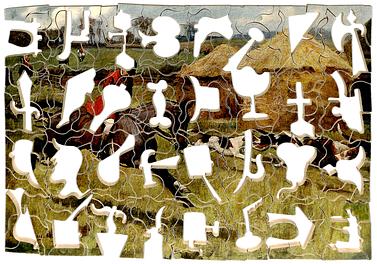
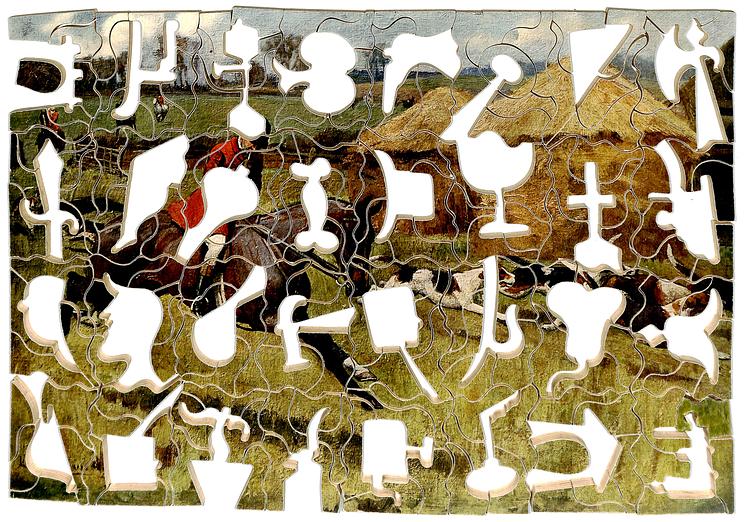


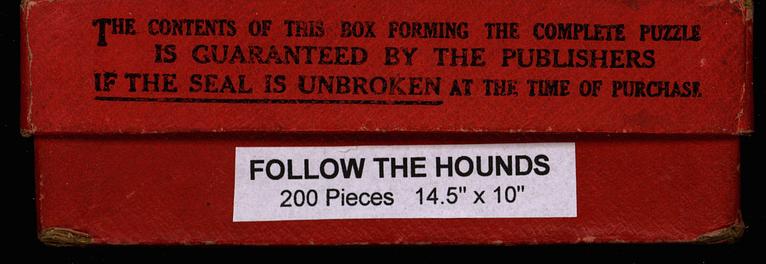
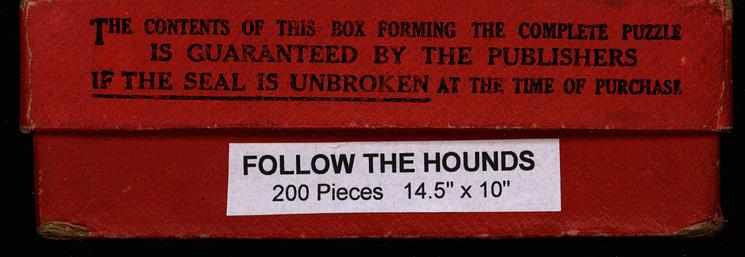
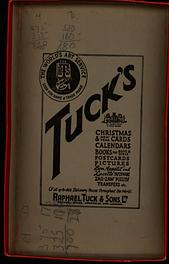
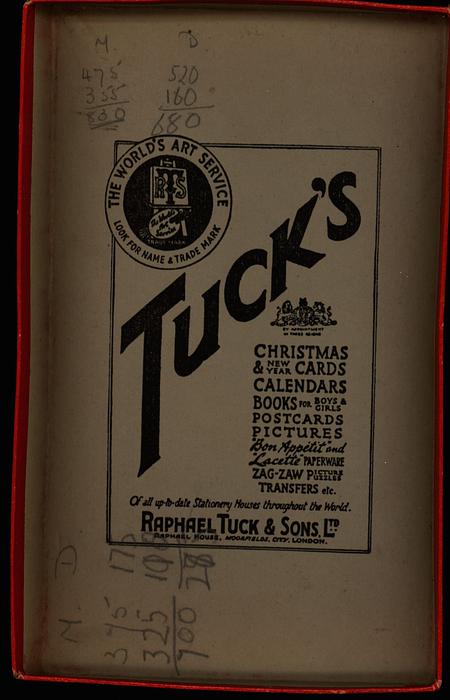
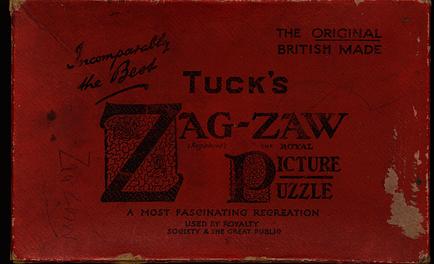

|
about 200 pieces, wooden, figurals, complete with box, one piece repaired, push fit style, also comes titled FULL CRY
|
|
|
|
Zag-Zaw line of puzzles was first produced in 1909, most incorporate figurals or whimsies, sold in red, orange, or occasionally green boxes with labels on the side or bottom of the box, most without guide pictures. Initially cut non-interlocking but by 1930's became more so. Puzzles have a different cuts so that the same image will come in several versions which means that missing pieces can not be taken from other puzzles with the same image. The puzzle labels are often hand written and come with minor variations in titles and details. Some have a DESIGN category on the label. From my readings this refers to the style of cut, wavy lines, figurals, etc. See also Bob Armstrong's website on old jigsaw puzzles
|
LIONEL EDWARDS (1878 – 1966)
|
|
14 1/2 x 10 in.
|
|
| ||||
| 110 |
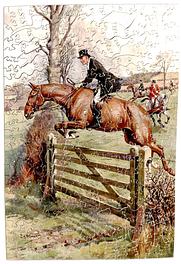
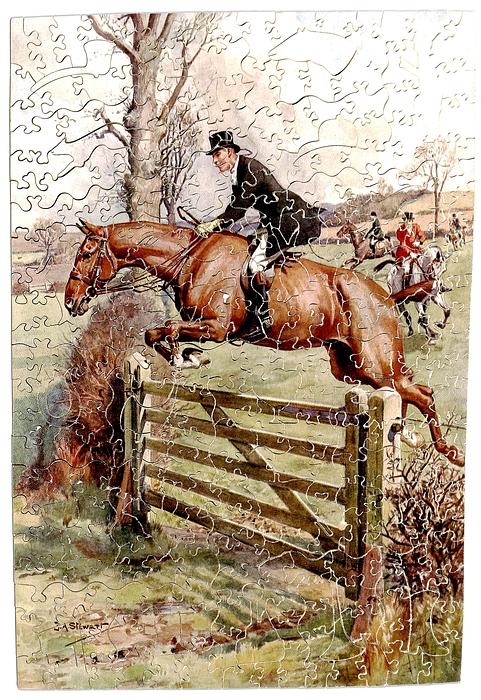
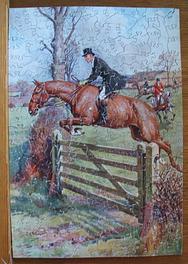
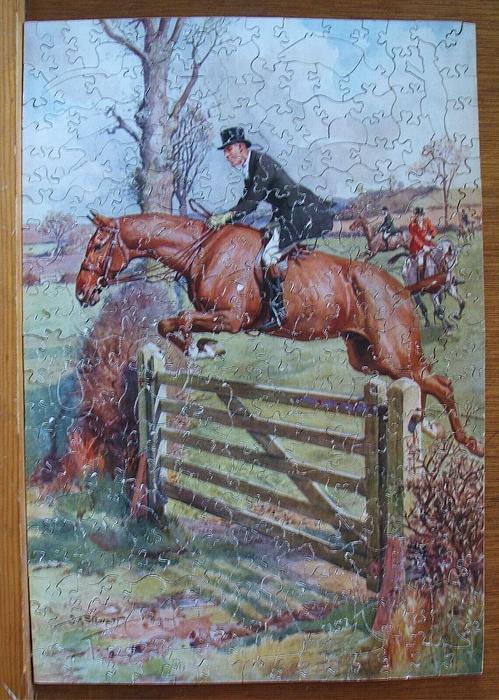
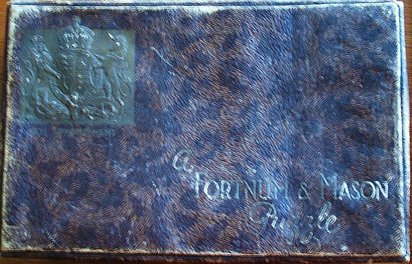

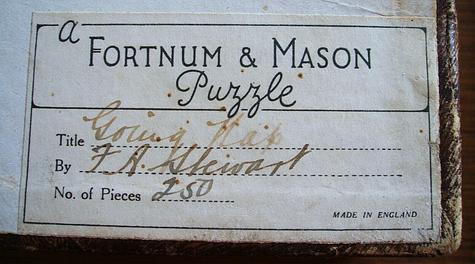
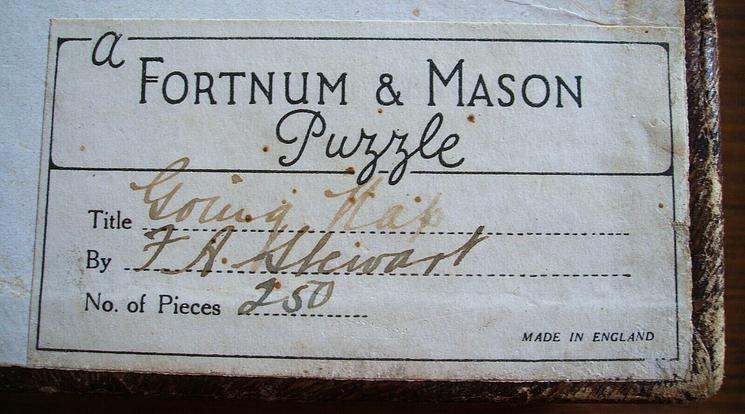
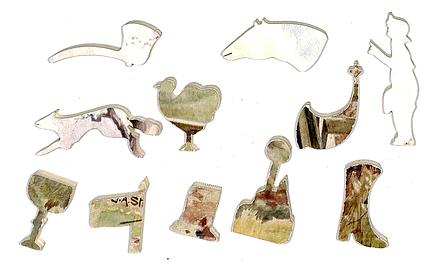
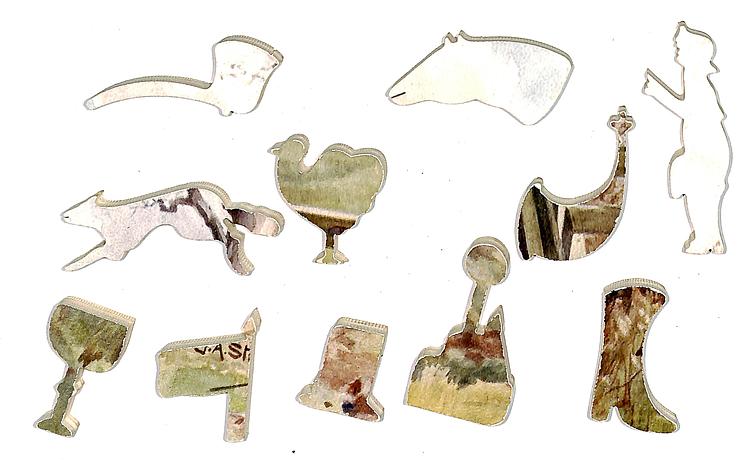
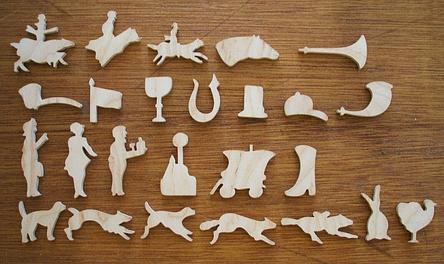
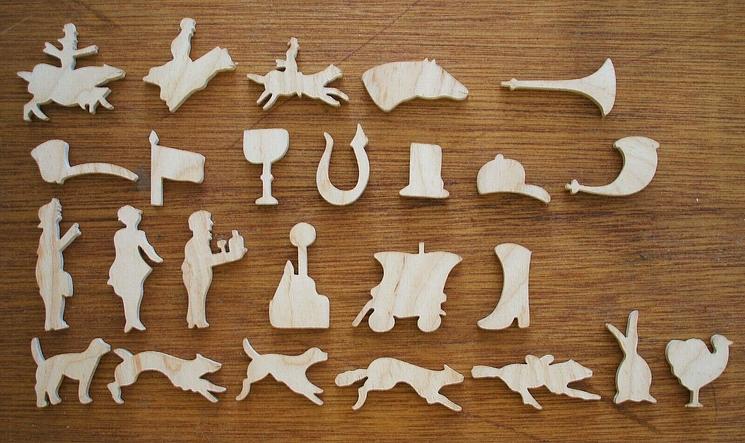
|
Manufactured by Raphael Tuck & Sons (not stated) but sold by Fortnum and Mason, 250 pieces as sated on box, wooden, with box, interlocking style with many figurals, Might not belong in the zag-zaw set and might not be Tuck as the figurals are not their style
|
|
|
|
Zag-Zaw line of puzzles was first produced in 1909, most incorporate figurals or whimsies, sold in red, orange, or occasionally green boxes with labels on the side or bottom of the box, most without guide pictures. Initially cut non-interlocking but by 1930's became more so. Puzzles have a different cuts so that the same image will come in several versions which means that missing pieces can not be taken from other puzzles with the same image. The puzzle labels are often hand written and come with minor variations in titles and details. Some have a DESIGN category on the label. From my readings this refers to the style of cut, wavy lines, figurals, etc. See also Bob Armstrong's website on old jigsaw puzzles
|
F. A. STEWART
|
|
9 1/2 x 14 in.
|
|
| ||||
| 111 |
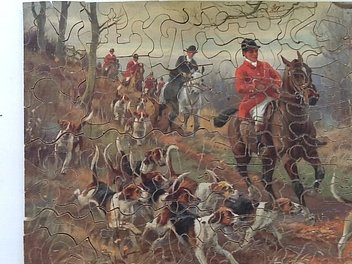


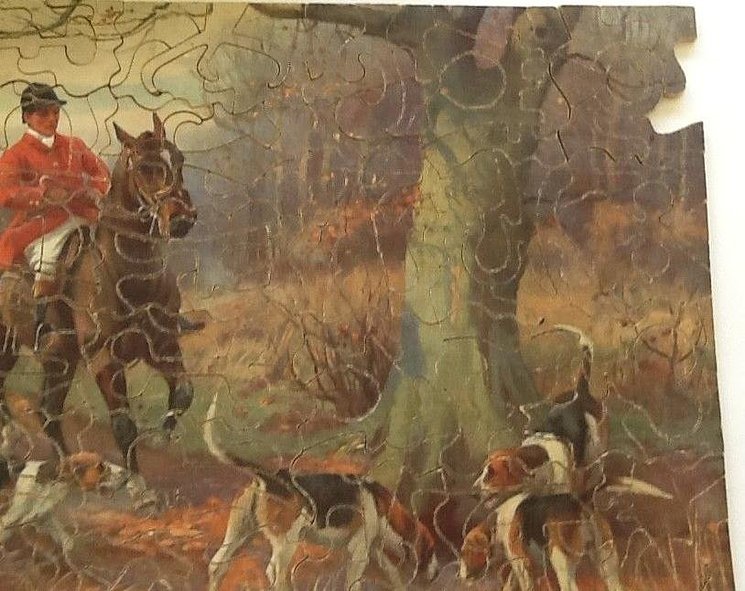
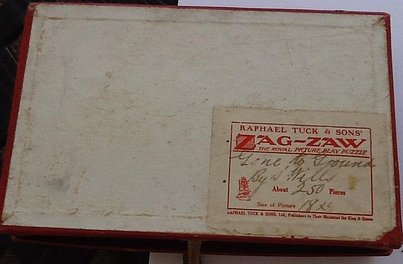

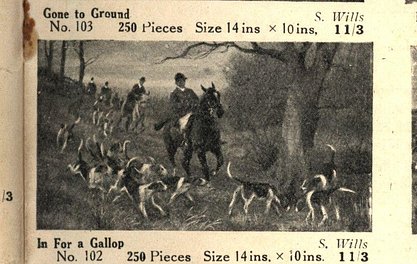
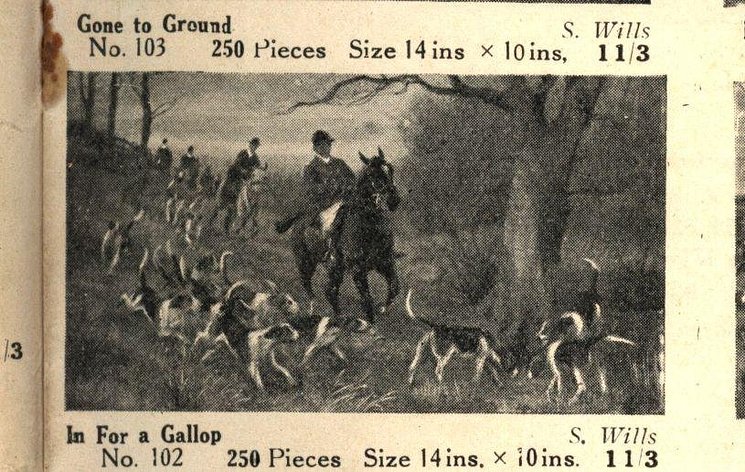
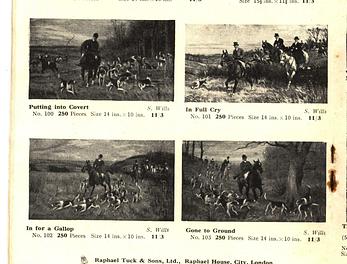
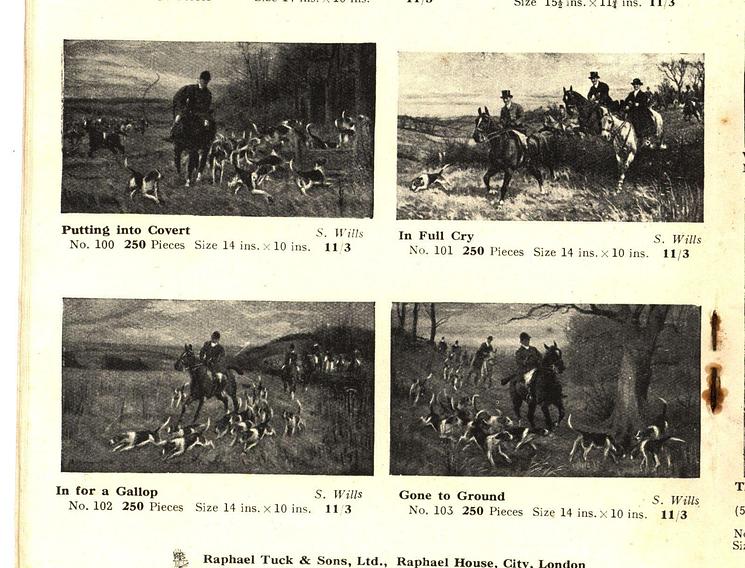
|
ABOUT 250 PIECES, listed and described in the catalogs as being number 103, listed and described in the catalogs as being number 103, also comes titled as IN FOR A GALLOP and numbered 102 in the catalogs
|
|
|
|
Zag-Zaw line of puzzles was first produced in 1909, most incorporate figurals or whimsies, sold in red, orange, or occasionally green boxes with labels on the side or bottom of the box, most without guide pictures. Initially cut non-interlocking but by 1930's became more so. Puzzles have a different cuts so that the same image will come in several versions which means that missing pieces can not be taken from other puzzles with the same image. The puzzle labels are often hand written and come with minor variations in titles and details. Some have a DESIGN category on the label. From my readings this refers to the style of cut, wavy lines, figurals, etc. See also Bob Armstrong's website on old jigsaw puzzles
|
S. Wills probably a pseudonym for John Sanderson-Wells (1872-1955)
|
|
17 1/2 x 9 1/2 in.
|
|
| ||||
| 112 |
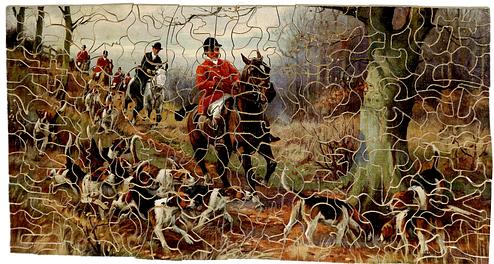

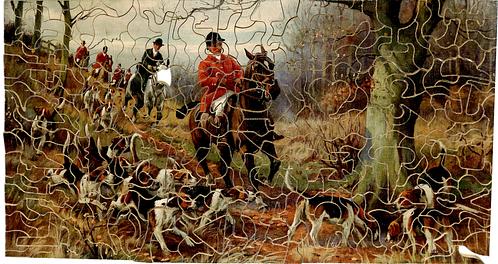
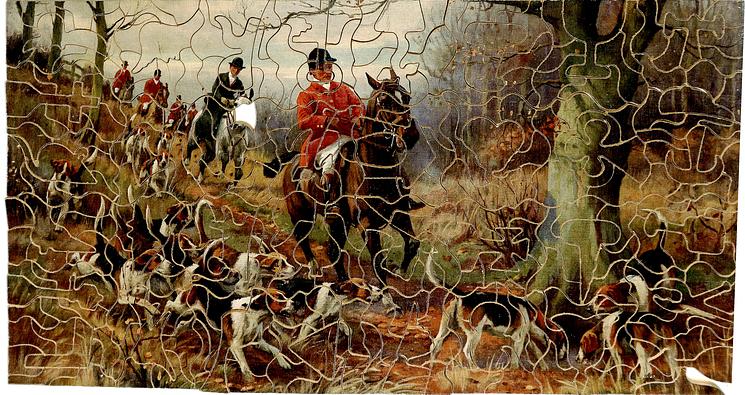
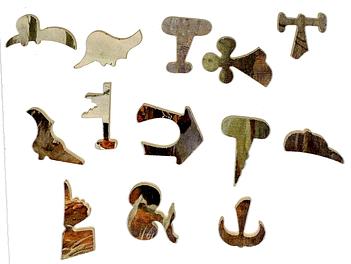


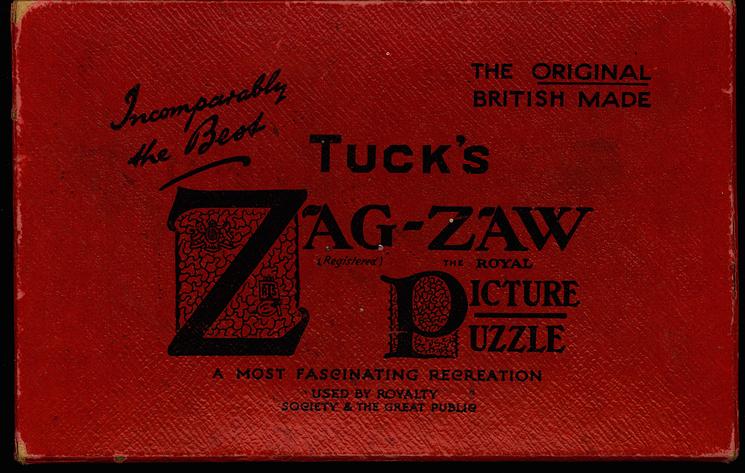
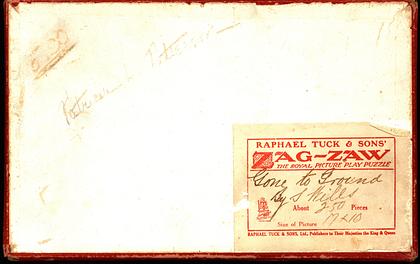

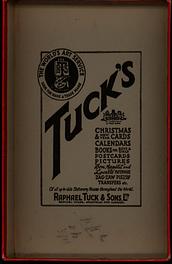

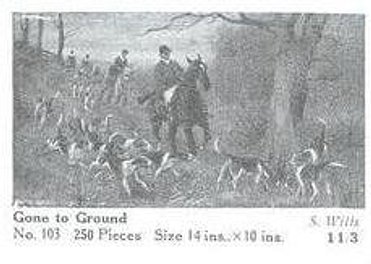
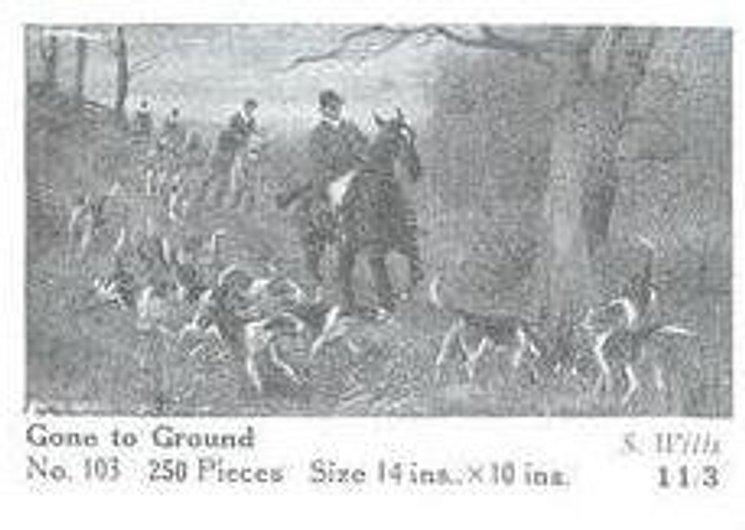
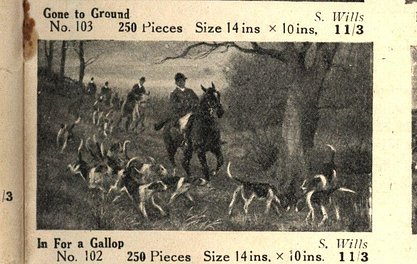

|
about 250 pieces, wooden, figurals, two pieces missing and replacements made, with box, push fit, listed and described in the catalogs as being number 103, also comes titled as IN FOR A GALLOP and numbered 102 in the catalogs
|
|
|
|
Zag-Zaw line of puzzles was first produced in 1909, most incorporate figurals or whimsies, sold in red, orange, or occasionally green boxes with labels on the side or bottom of the box, most without guide pictures. Initially cut non-interlocking but by 1930's became more so. Puzzles have a different cuts so that the same image will come in several versions which means that missing pieces can not be taken from other puzzles with the same image. The puzzle labels are often hand written and come with minor variations in titles and details. Some have a DESIGN category on the label. From my readings this refers to the style of cut, wavy lines, figurals, etc. See also Bob Armstrong's website on old jigsaw puzzles
|
S. WILLS probably a pseudonym for John Sanderson-Wells (1872-1955)
|
|
17 1/2 x 9 1/4 in.
|
|
| ||||
| 113 |
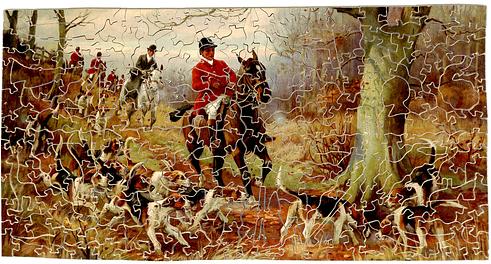

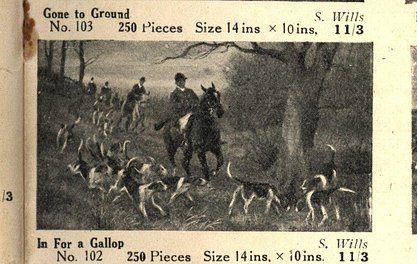
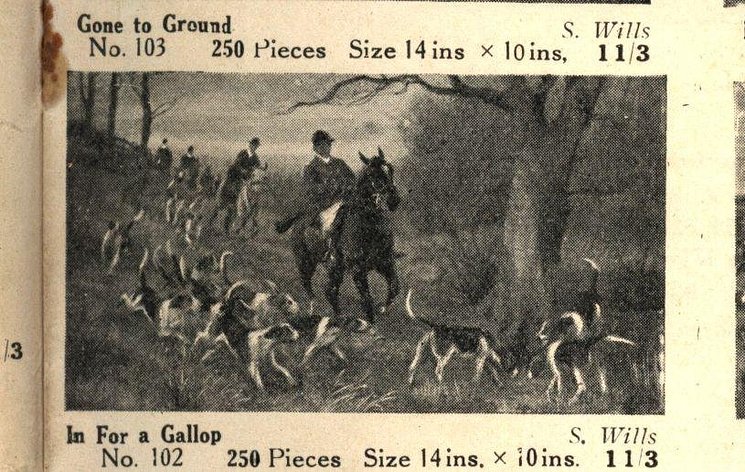
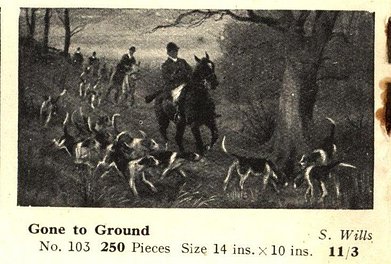
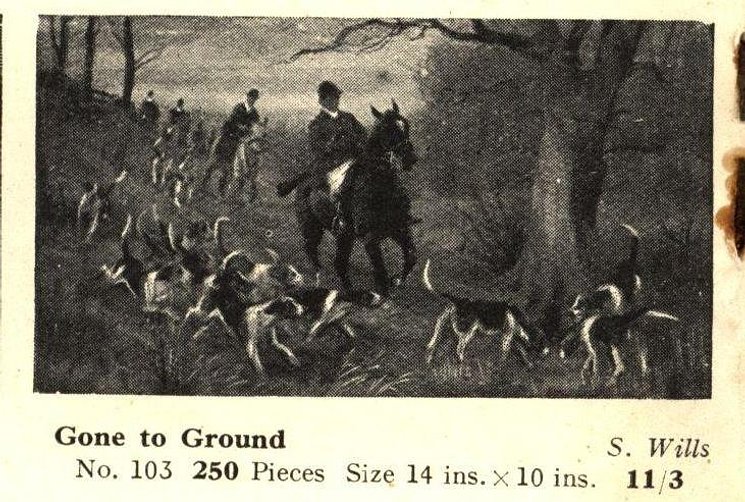
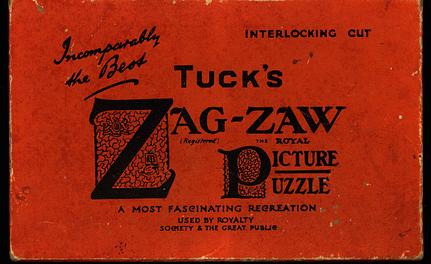

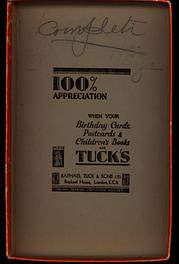
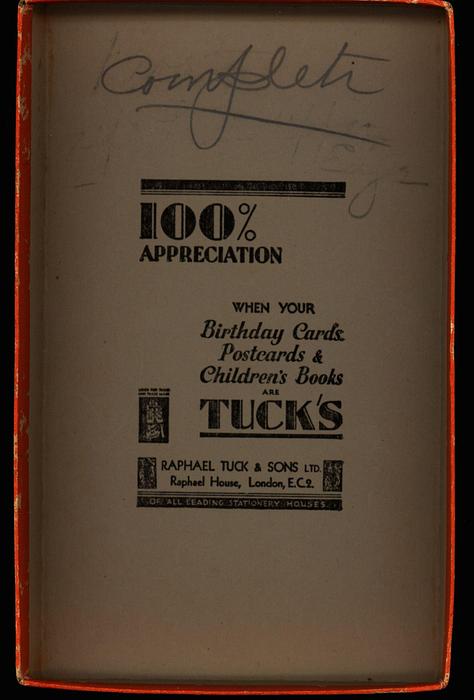
|
about 250 pieces, wooden, figurals, complete with box, interlocking style, listed and described in the catalogs as being number 103, also comes titled as IN FOR A GALLOP and numbered 102 in the catalogs, no label on box
|
|
|
|
Zag-Zaw line of puzzles was first produced in 1909, most incorporate figurals or whimsies, sold in red, orange, or occasionally green boxes with labels on the side or bottom of the box, most without guide pictures. Initially cut non-interlocking but by 1930's became more so. Puzzles have a different cuts so that the same image will come in several versions which means that missing pieces can not be taken from other puzzles with the same image. The puzzle labels are often hand written and come with minor variations in titles and details. Some have a DESIGN category on the label. From my readings this refers to the style of cut, wavy lines, figurals, etc. See also Bob Armstrong's website on old jigsaw puzzles
|
S. WILLS probably a pseudonym for John Sanderson-Wells (1872-1955)
|
|
17 1/2 x 9 1/4 in.
|
|
| ||||
| 114 |
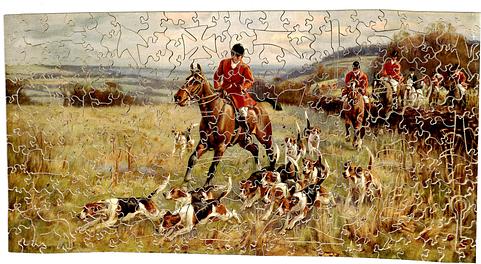


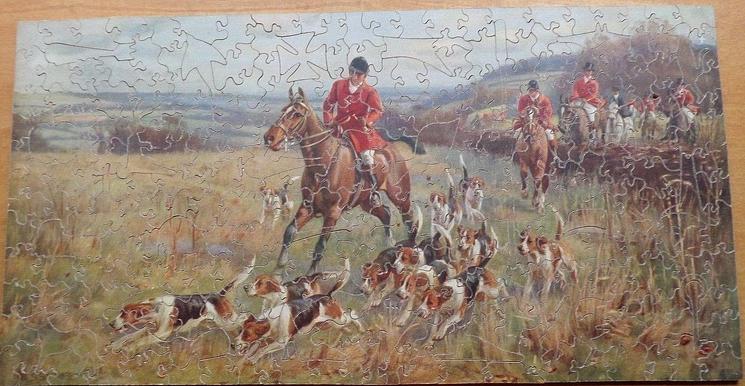
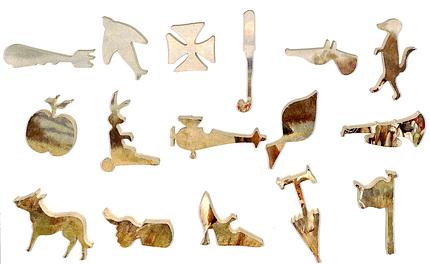

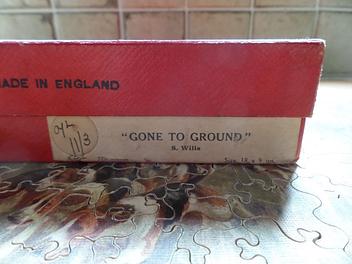
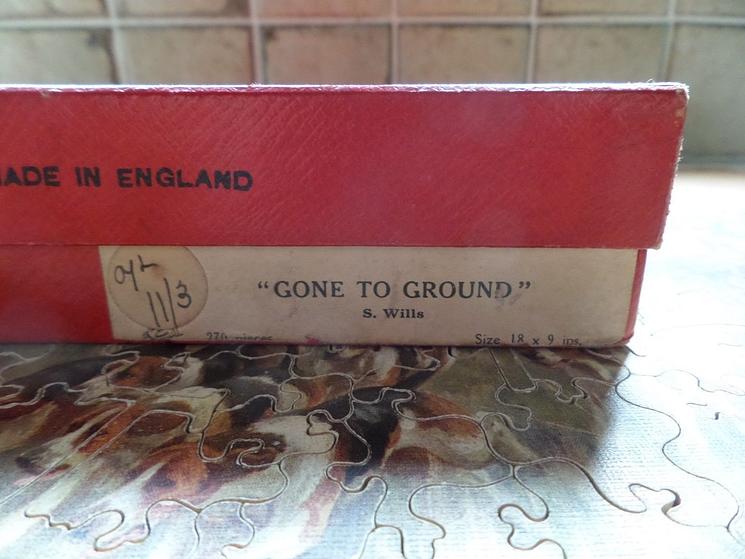
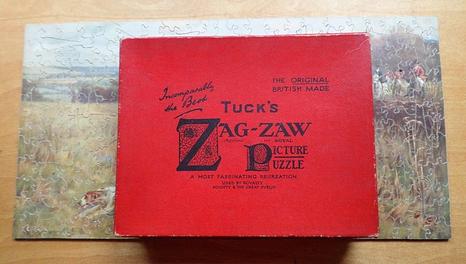
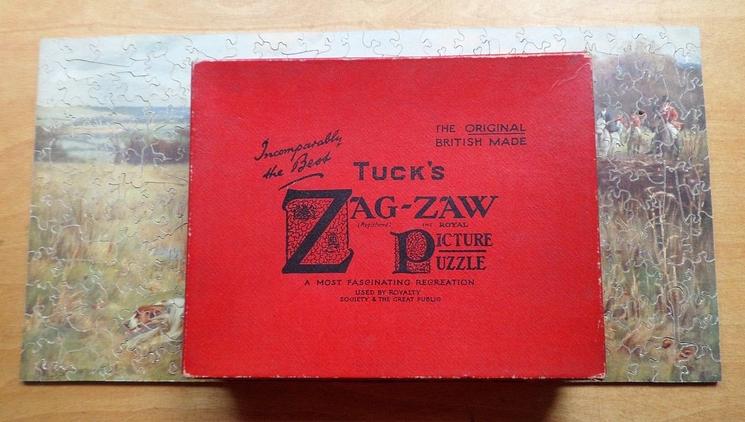
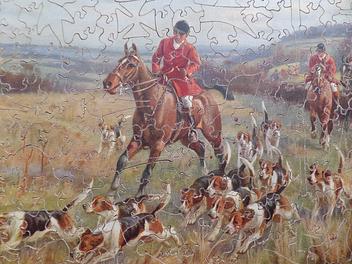

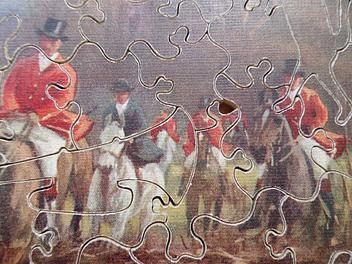
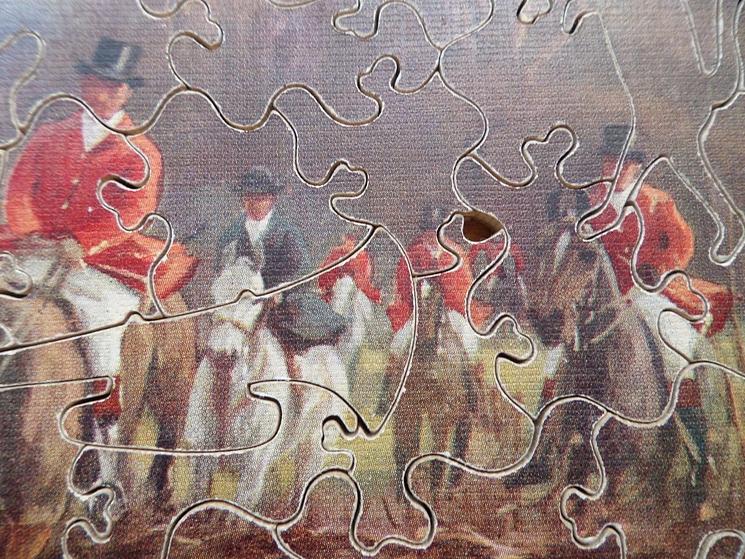
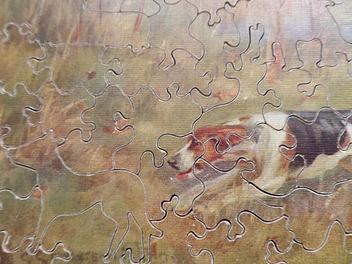

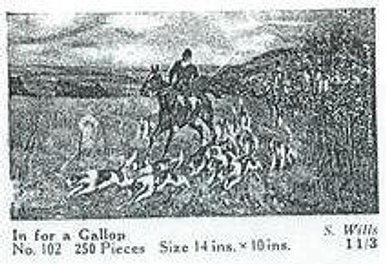

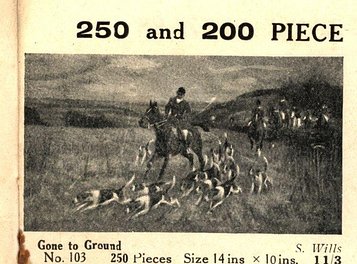
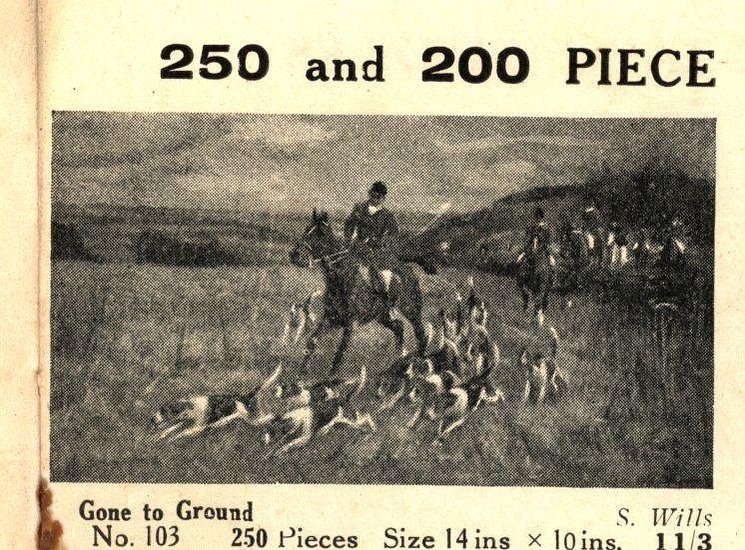
|
270 PIECES, wooden, figurals, complete with box, interlocking in style, same image comes with two titles-IN FOR A GALLOP and GONE TO GROUND, titles confirmed with catalog entries, listed and described as number 102 and 103 in the catalogs,
|
|
|
|
Zag-Zaw line of puzzles was first produced in 1909, most incorporate figurals or whimsies, sold in red, orange, or occasionally green boxes with labels on the side or bottom of the box, most without guide pictures. Initially cut non-interlocking but by 1930's became more so. Puzzles have a different cuts so that the same image will come in several versions which means that missing pieces can not be taken from other puzzles with the same image. The puzzle labels are often hand written and come with minor variations in titles and details. Some have a DESIGN category on the label. From my readings this refers to the style of cut, wavy lines, figurals, etc. See also Bob Armstrong's website on old jigsaw puzzles
|
S. Wills probably a pseudonym for John Sanderson-Wells (1872-1955)
|
|
18 x 9 in.
|
|
| ||||
| 115 |
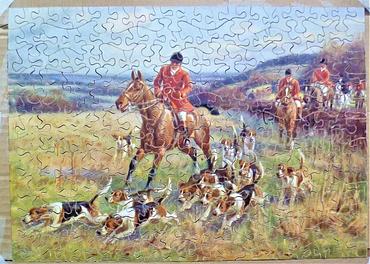

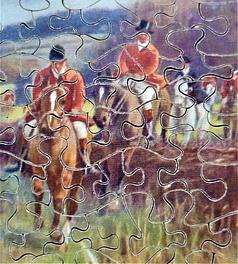



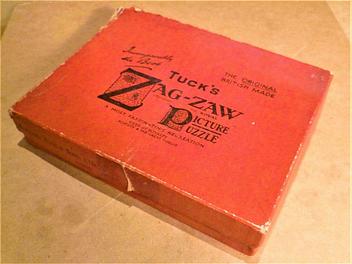

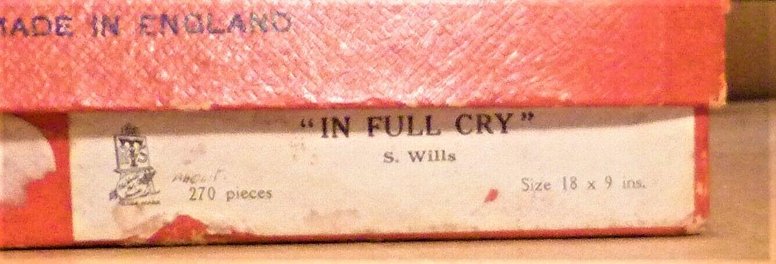
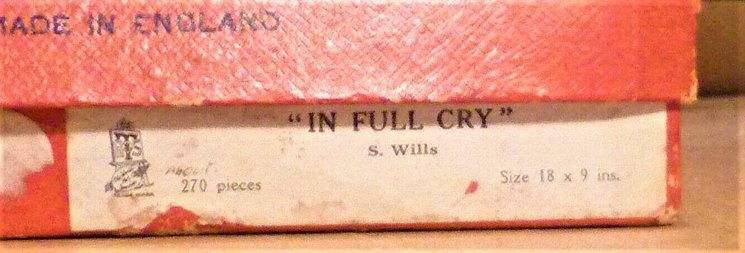
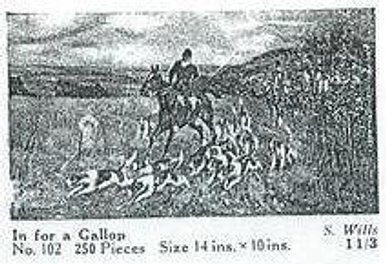
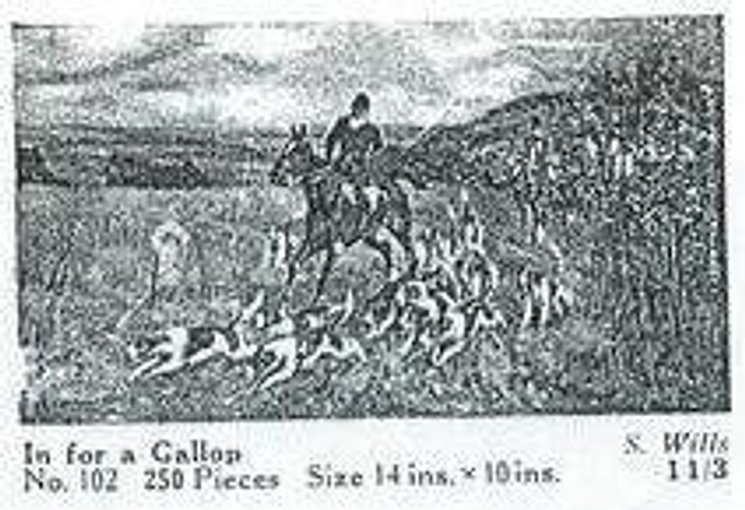
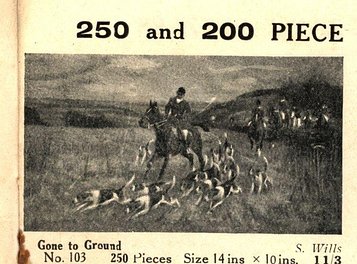

|
270 pieces, wooden, interlocking in style, complete, same image comes with two titles-IN FOR A GALLOP and GONE TO GROUND, titles confirmed with catalog entries, this copy is possibly a Salmon academy puzzle in the wrong box, listed and described as number 102 and 103 in the catalogs,
|
|
|
|
Zag-Zaw line of puzzles was first produced in 1909, most incorporate figurals or whimsies, sold in red, orange, or occasionally green boxes with labels on the side or bottom of the box, most without guide pictures. Initially cut non-interlocking but by 1930's became more so. Puzzles have a different cuts so that the same image will come in several versions which means that missing pieces can not be taken from other puzzles with the same image. The puzzle labels are often hand written and come with minor variations in titles and details. Some have a DESIGN category on the label. From my readings this refers to the style of cut, wavy lines, figurals, etc. See also Bob Armstrong's website on old jigsaw puzzles
|
S. Wills probably a pseudonym for John Sanderson-Wells (1872-1955)
|
|
35 x 25 cm, 18 x 9 in.
|
|
| ||||
| 116 |
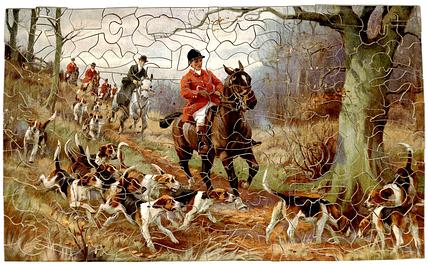

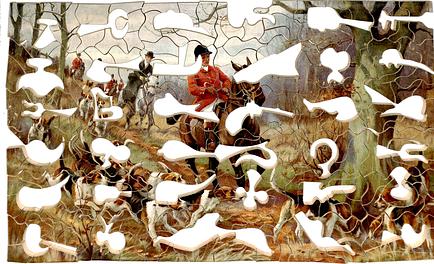



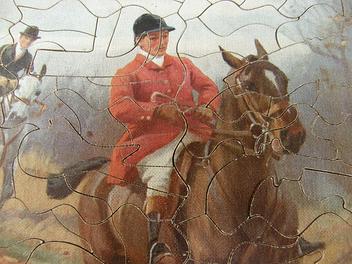

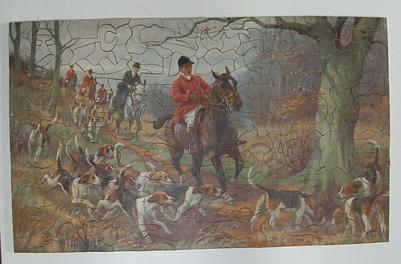
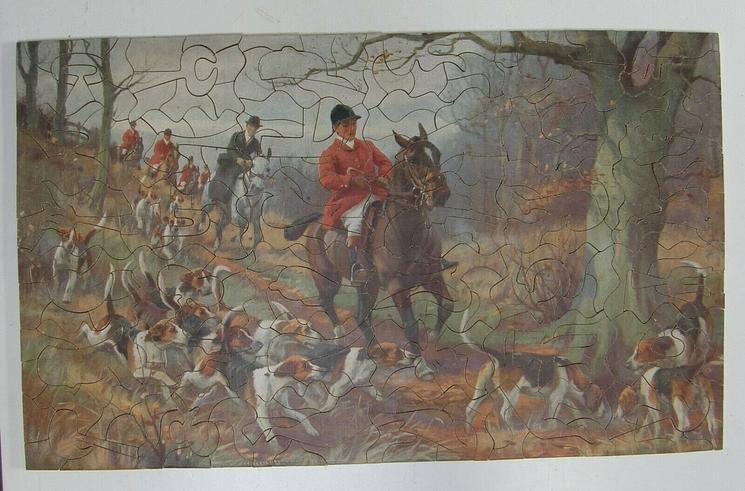
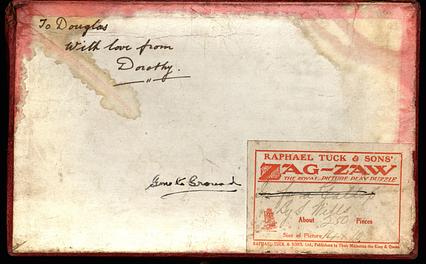
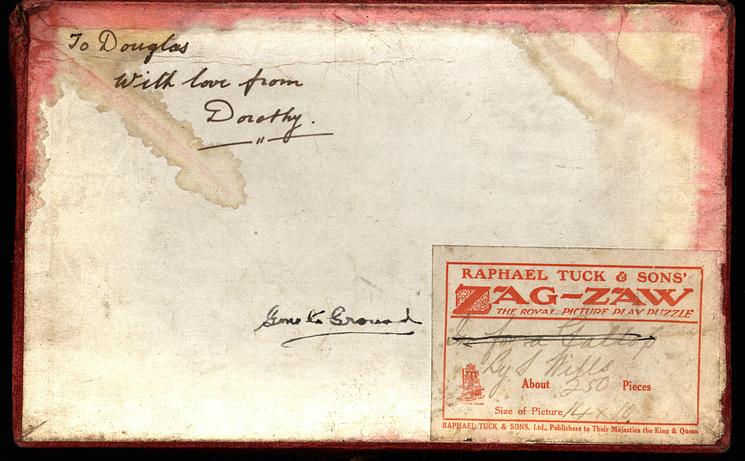
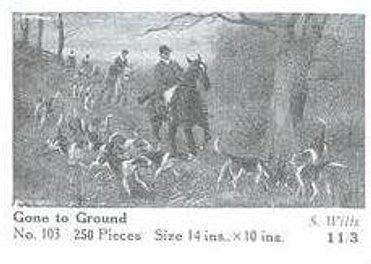

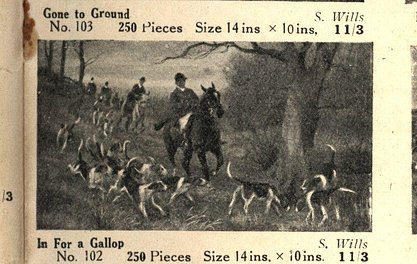
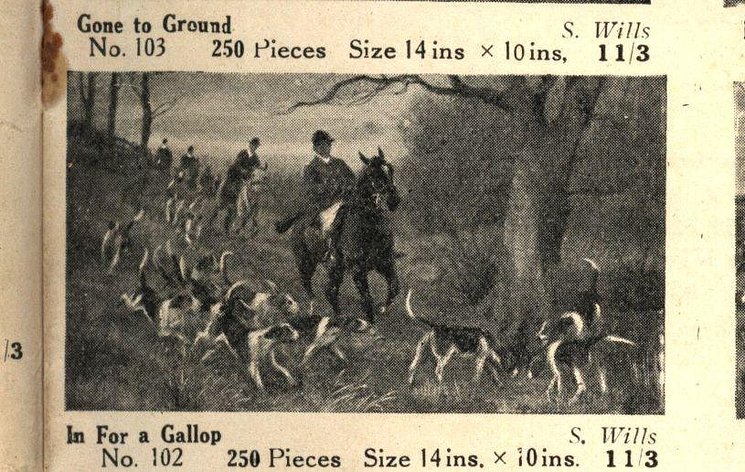
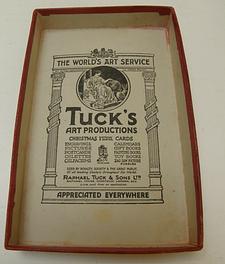
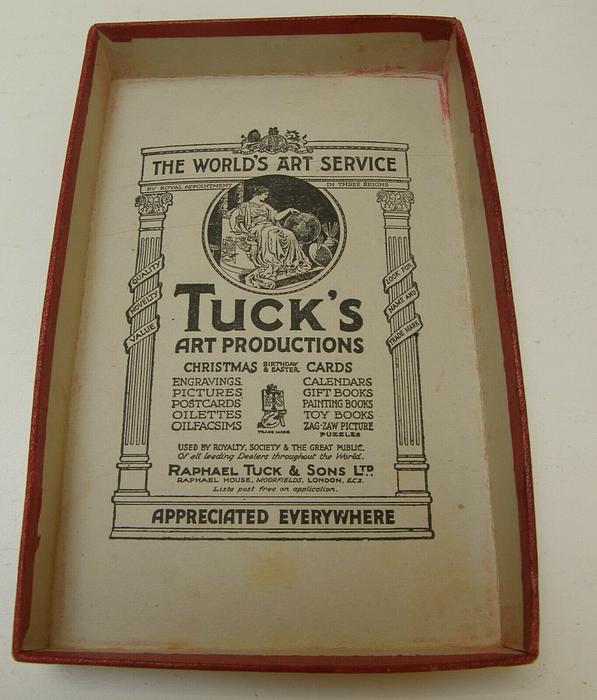
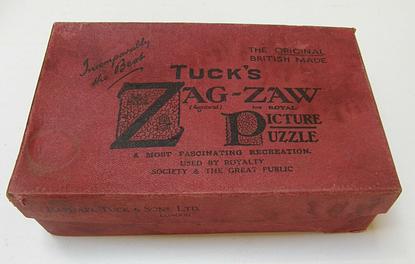
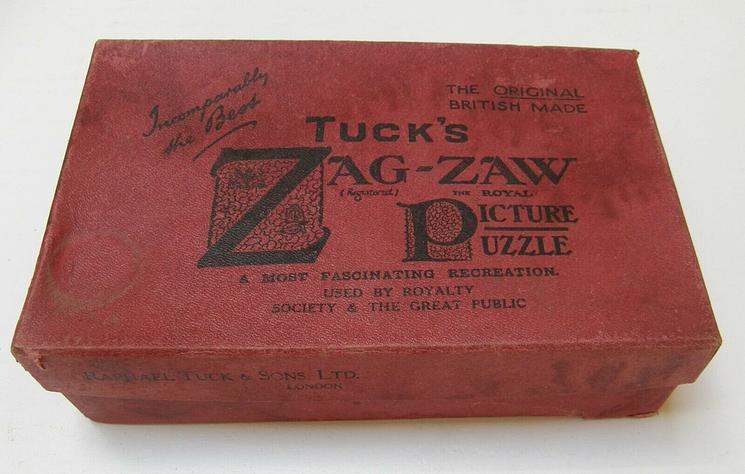
|
270 pieces, wooden, figurals, complete with one broken but present nib, push-fit, listed and described in the catalogs as being number 103, also comes titled as GONE TO GROUND and numbered 102 in the catalogs
|
|
|
|
Zag-Zaw line of puzzles was first produced in 1909, most incorporate figurals or whimsies, sold in red, orange, or occasionally green boxes with labels on the side or bottom of the box, most without guide pictures. Initially cut non-interlocking but by 1930's became more so. Puzzles have a different cuts so that the same image will come in several versions which means that missing pieces can not be taken from other puzzles with the same image. The puzzle labels are often hand written and come with minor variations in titles and details. Some have a DESIGN category on the label. From my readings this refers to the style of cut, wavy lines, figurals, etc. See also Bob Armstrong's website on old jigsaw puzzles
|
S. Wills probably a pseudonym for John Sanderson-Wells (1872-1955)
|
|
16 x 10 in.
|
|
| ||||
| 117 |
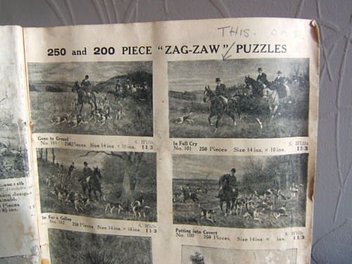
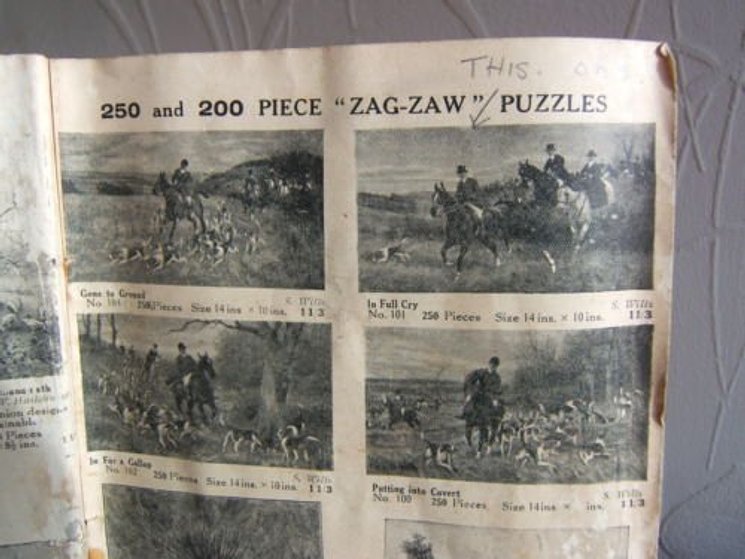
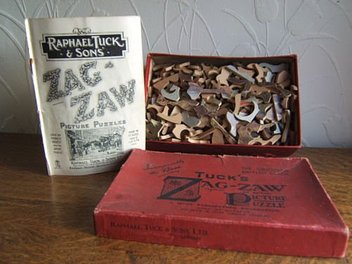
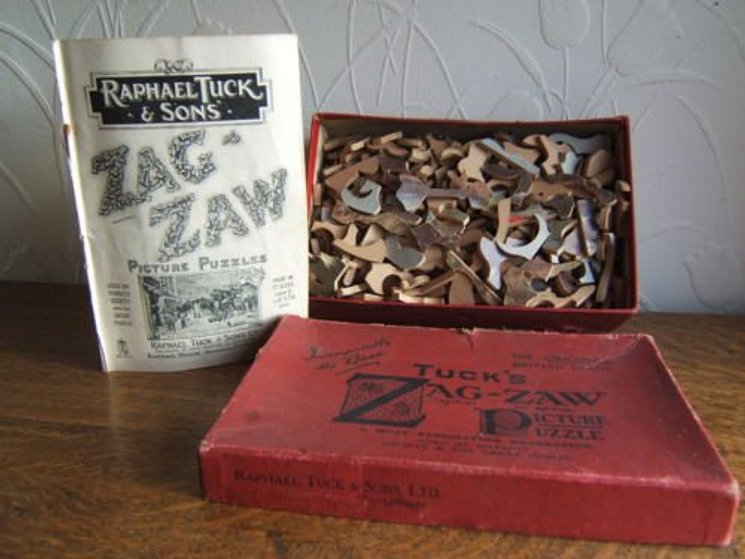
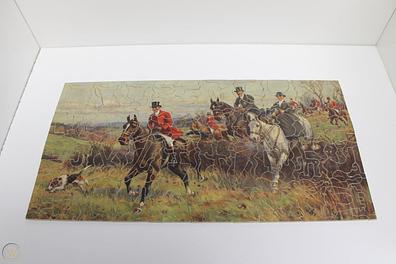

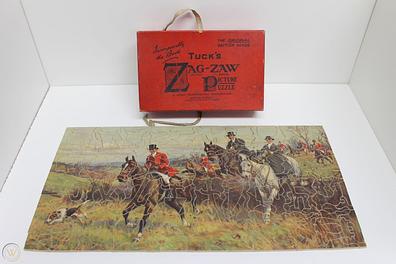
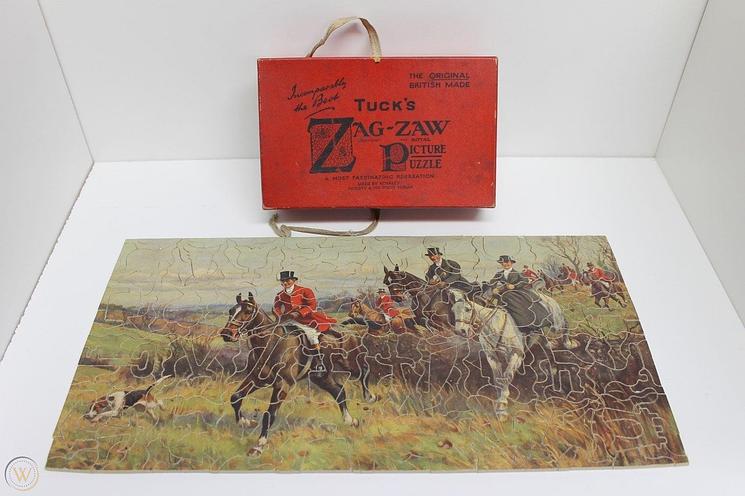

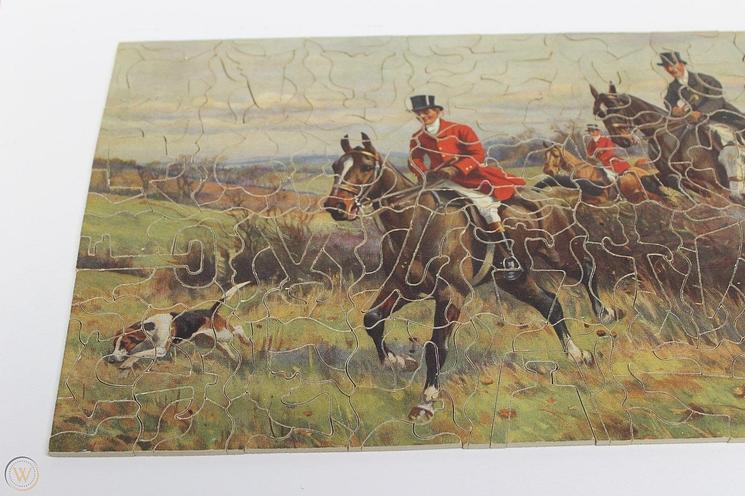
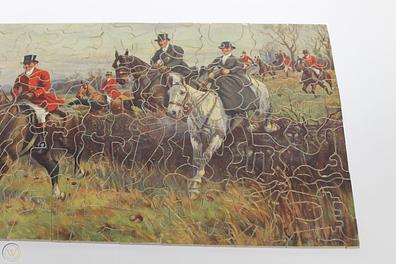

|
250 pieces,
|
|
|
|
Zag-Zaw line of puzzles was first produced in 1909, most incorporate figurals or whimsies, sold in red, orange, or occasionally green boxes with labels on the side or bottom of the box, most without guide pictures. Initially cut non-interlocking but by 1930's became more so. Puzzles have a different cuts so that the same image will come in several versions which means that missing pieces can not be taken from other puzzles with the same image. The puzzle labels are often hand written and come with minor variations in titles and details. Some have a DESIGN category on the label. From my readings this refers to the style of cut, wavy lines, figurals, etc. See also Bob Armstrong's website on old jigsaw puzzles
|
S. Wills probably a pseudonym for John Sanderson-Wells (1872-1955)
|
|
14 x 10 in.
|
|
| ||||
| 118 |
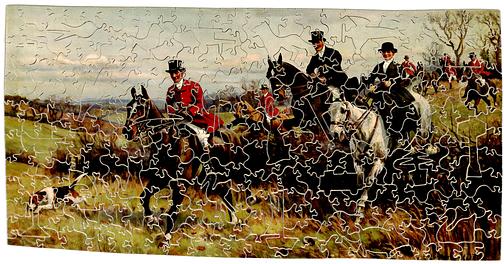

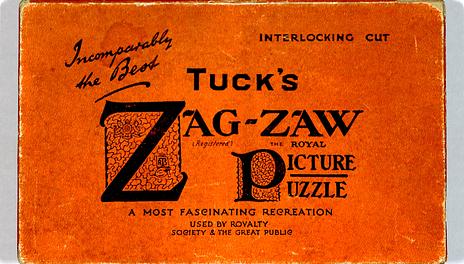
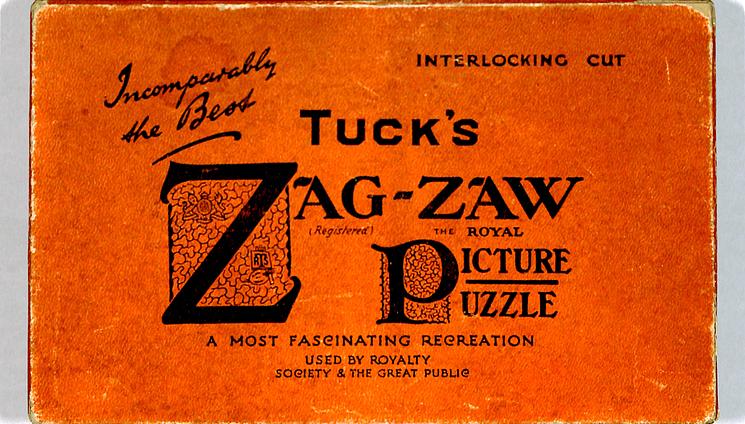
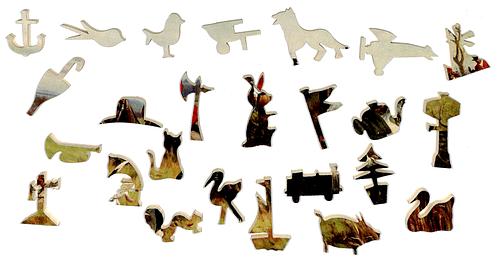
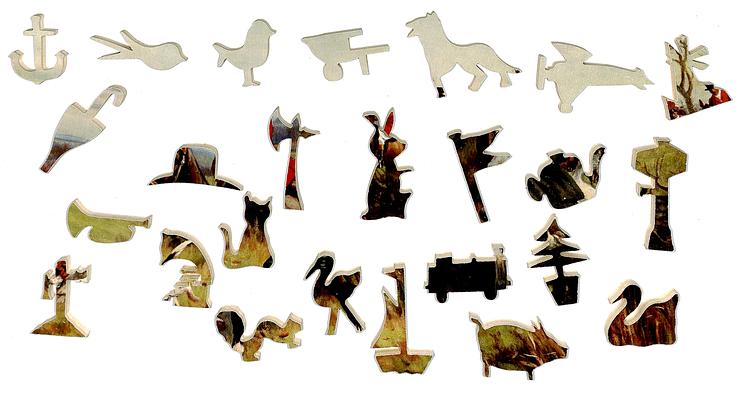
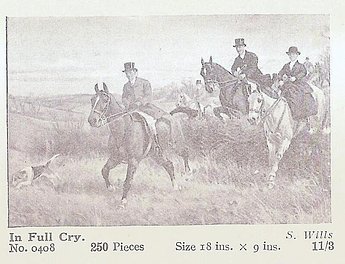
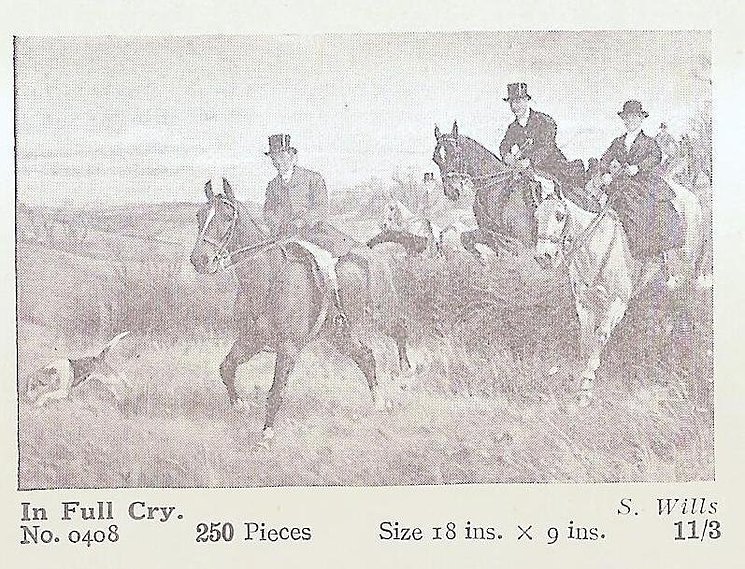
|
about 200 pieces, wooden, complete with box, interlocking in style, listed and described in the catalogs as 0408 and also comes with that number on the label
|
|
|
|
Zag-Zaw line of puzzles was first produced in 1909, most incorporate figurals or whimsies, sold in red, orange, or occasionally green boxes with labels on the side or bottom of the box, most without guide pictures. Initially cut non-interlocking but by 1930's became more so. Puzzles have a different cuts so that the same image will come in several versions which means that missing pieces can not be taken from other puzzles with the same image. The puzzle labels are often hand written and come with minor variations in titles and details. Some have a DESIGN category on the label. From my readings this refers to the style of cut, wavy lines, figurals, etc. See also Bob Armstrong's website on old jigsaw puzzles
|
S. Wills probably a pseudonym for John Sanderson-Wells (1872-1955)
|
|
16 3/4 x 9 1/2 in.
|
|
| ||||
| 119 |

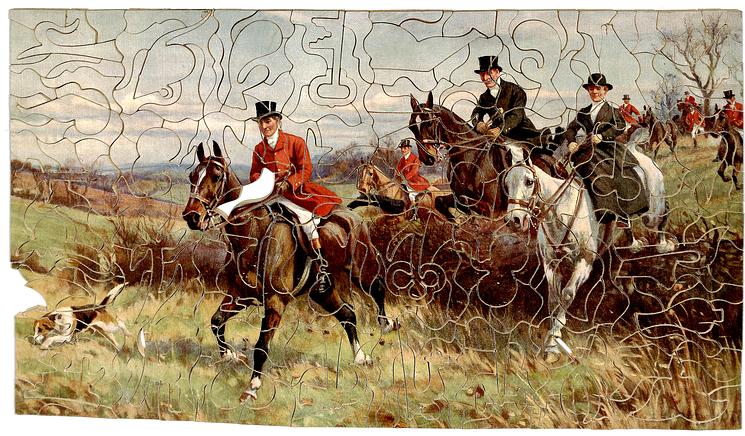
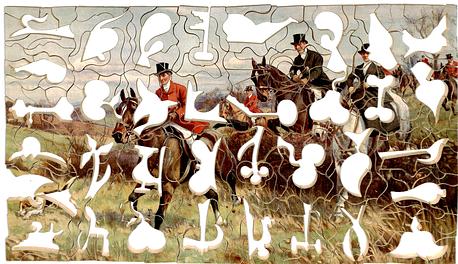
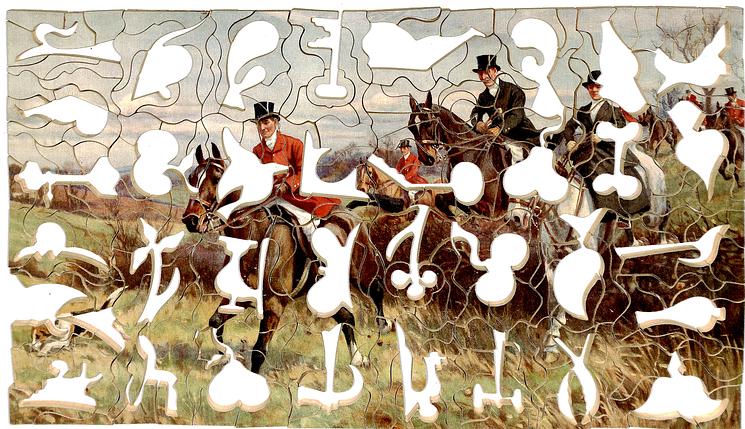
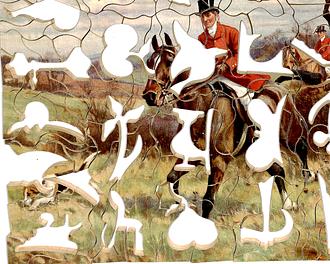
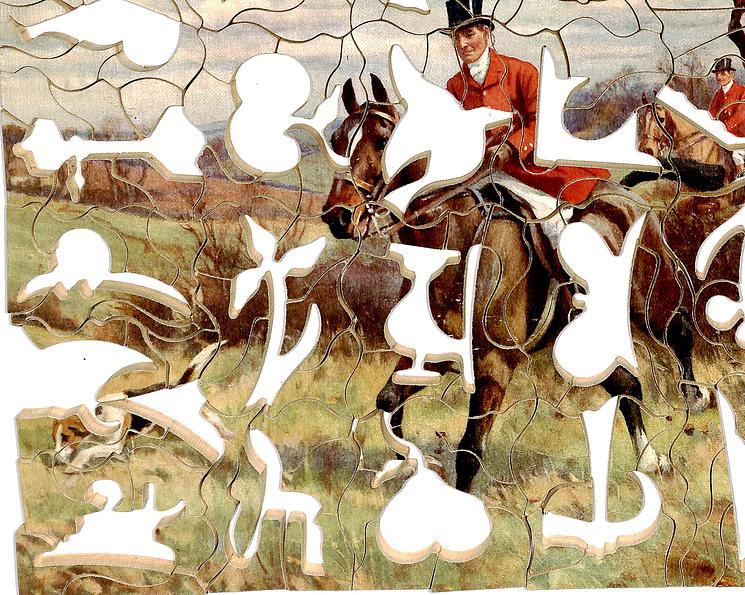
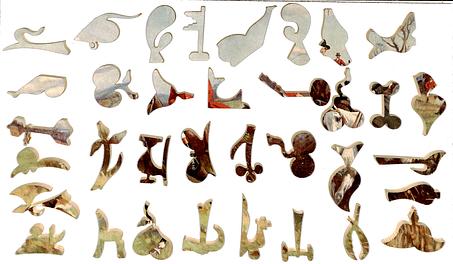
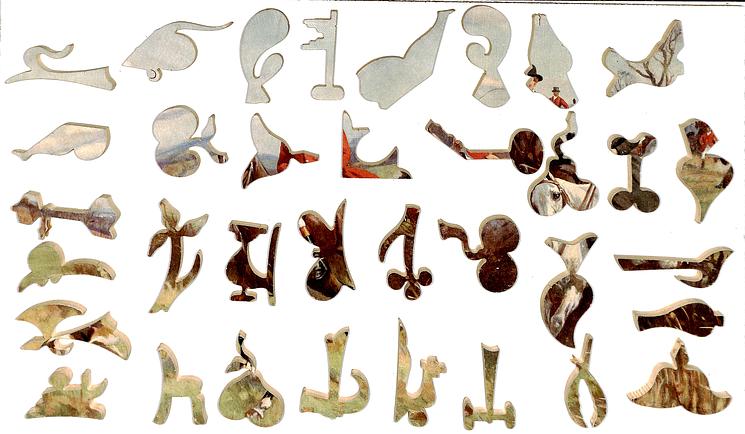
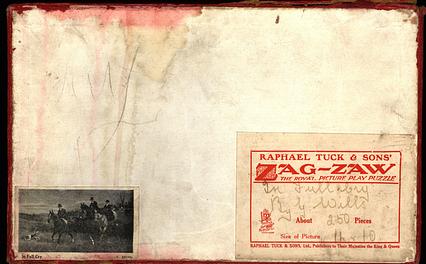
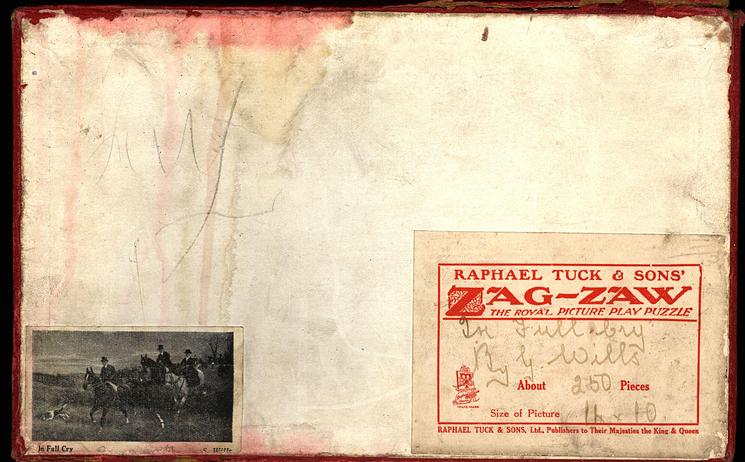
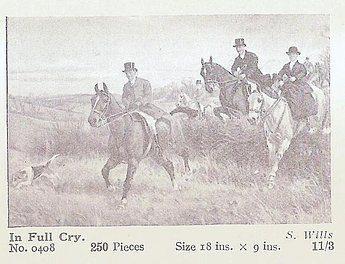
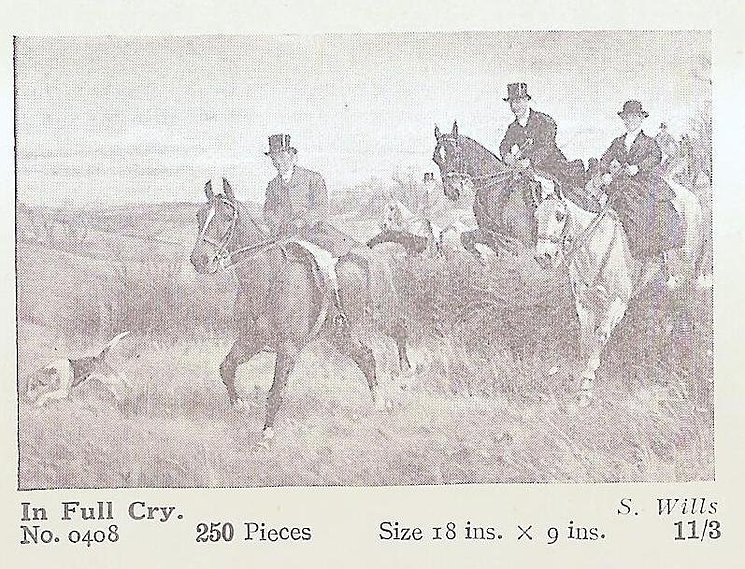
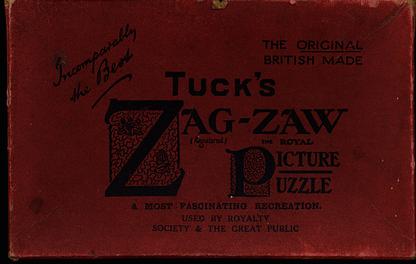

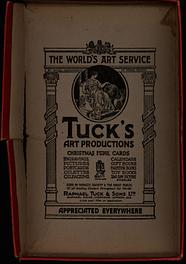
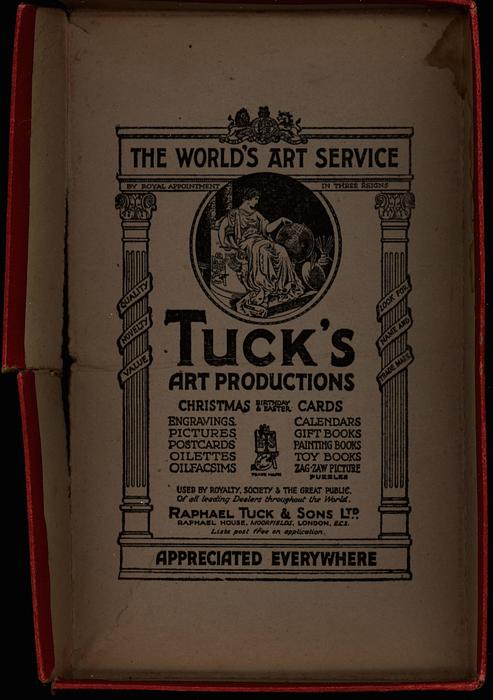
|
about 250 pieces, wooden, figurals, missing two pieces and two nibs, with box, listed and described in the catalogs as 0408 and also comes with that number on the label
|
|
|
|
Zag-Zaw line of puzzles was first produced in 1909, most incorporate figurals or whimsies, sold in red, orange, or occasionally green boxes with labels on the side or bottom of the box, most without guide pictures. Initially cut non-interlocking but by 1930's became more so. Puzzles have a different cuts so that the same image will come in several versions which means that missing pieces can not be taken from other puzzles with the same image. The puzzle labels are often hand written and come with minor variations in titles and details. Some have a DESIGN category on the label. From my readings this refers to the style of cut, wavy lines, figurals, etc. See also Bob Armstrong's website on old jigsaw puzzles
|
S. Wills probably a pseudonym for John Sanderson-Wells (1872-1955)
|
|
16 3/4 x 9 1/2 in.
|
|
| ||||
| 120 |
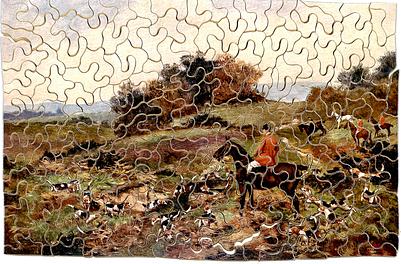

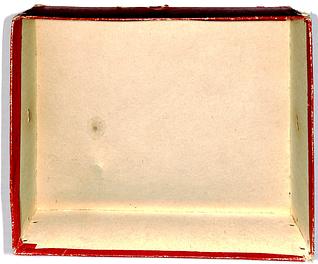
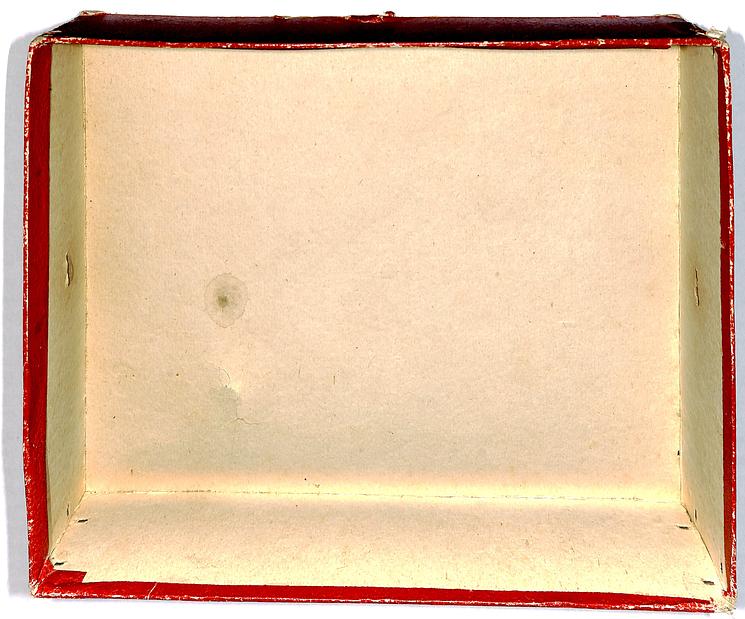
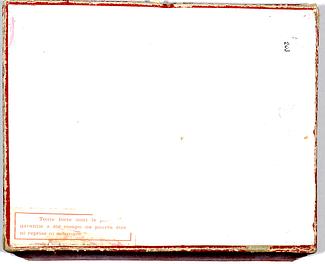
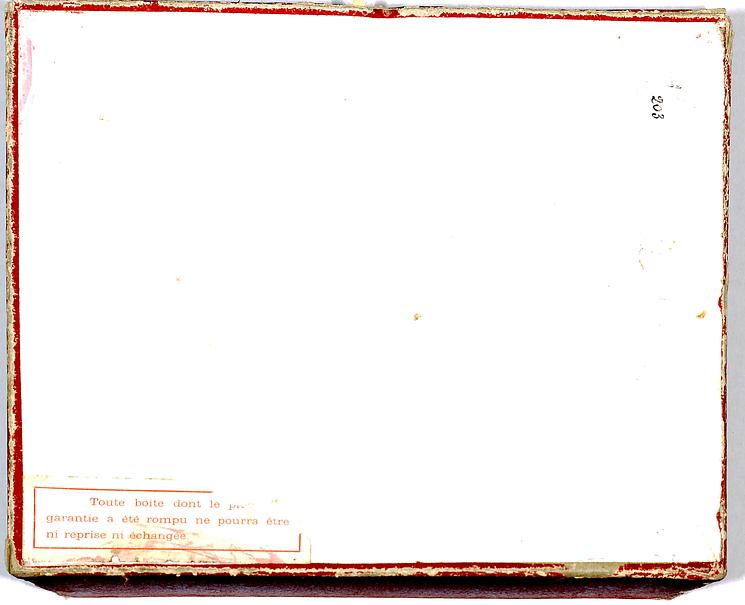
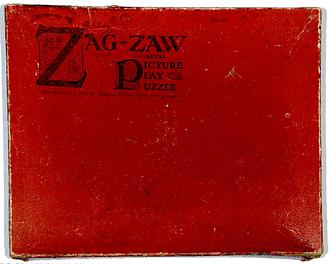
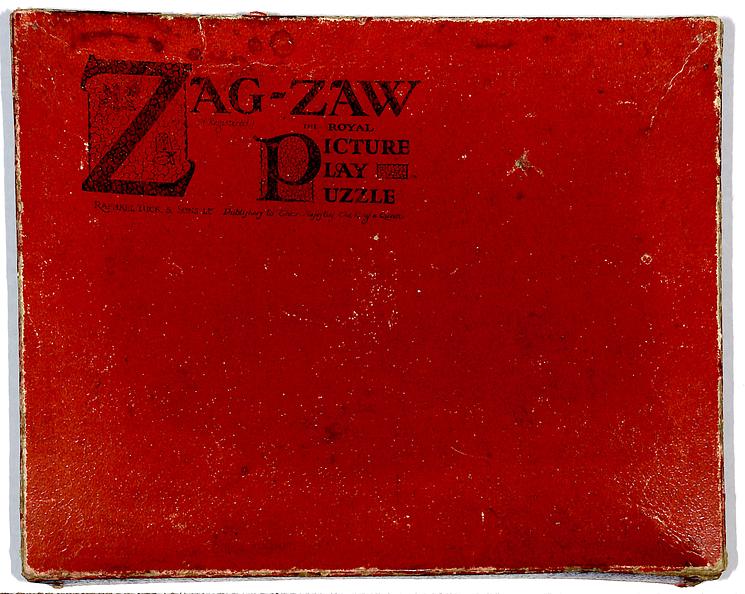


|
not a Tuck title sticker so may be incorrectly named, about 200 pieces, wooden, complete with Tuck box, push fit style
|
|
|
|
Zag-Zaw line of puzzles was first produced in 1909, most incorporate figurals or whimsies, sold in red, orange, or occasionally green boxes with labels on the side or bottom of the box, most without guide pictures. Initially cut non-interlocking but by 1930's became more so. Puzzles have a different cuts so that the same image will come in several versions which means that missing pieces can not be taken from other puzzles with the same image. The puzzle labels are often hand written and come with minor variations in titles and details. Some have a DESIGN category on the label. From my readings this refers to the style of cut, wavy lines, figurals, etc. See also Bob Armstrong's website on old jigsaw puzzles
|
G.D. ROWLANDSON
|
|
11 1/2 x 7 1/2 in.
|
|
|